Flycatchers are a large and diverse family of birds found throughout the world. They are known for their ability to catch flying insects mid-air, and can be identified by their distinctive shape, size, and behavior.
They vary greatly in size, ranging from the tiny kinglets to the large flycatchers. Their habitat varies depending on the species, with some inhabiting forests and others living in open areas.
They are an important indicator species for the health of their environment, as their presence serves as a sign of a healthy and well-balanced ecosystem.
1. Alder Flycatcher
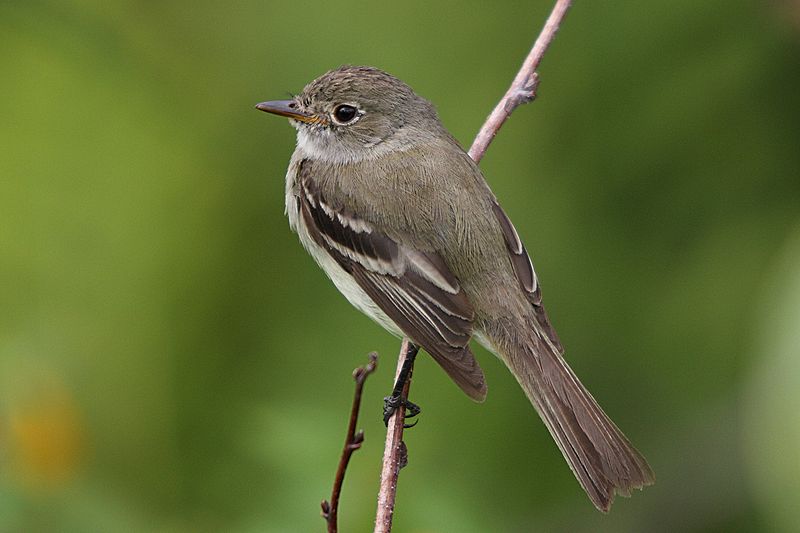
The alder flycatcher is an insect-eating bird belonging to the tyrant flycatcher family. It has a length of 13–17 cm and weighs 12–14 g, with its wingspan ranging from 21–25 cm.
This species can be identified by its greyish brown upperparts and white underparts, in addition to yellow wing bars on each side.
Its bill is dark grey with a black tip, while its legs are pinkish or light gray in colour.
The call of this bird includes both high pitched whistles as well as chirps that sound like “spizik”.
During the breeding season it prefers wet woodlands near water sources such as rivers, streams or lakes – where it builds cup shaped nests within shrubs close to ground level.
These birds feed predominantly on insects but may also occasionally consume fruits during winter months when their preferred food source becomes scarce.Scientific classification:
| Kingdom | Animalia |
| Phylum | Chordata |
| Class | Aves |
| Order | Passeriformes |
| Family | Tyrannidae |
| Genus | Empidonax |
| Species | E. alnorum |
Also Featured In: Willows Birds Around You, Adirondack Mountain Birds
2. American Dusky Flycatcher
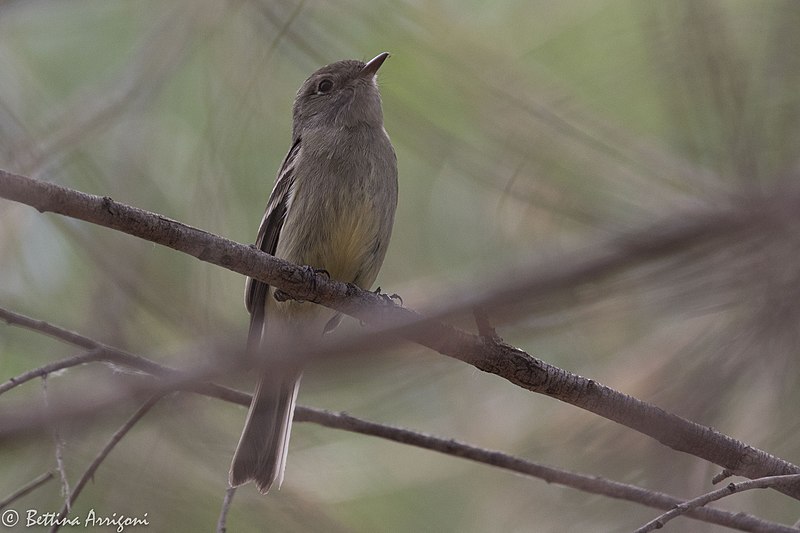
The American dusky flycatcher is a small insectivorous passerine belonging to the tyrant flycatcher family. It is one of many species in the Empidonax genus, which can be difficult to differentiate from each other due to their similar appearance and behavior.
The best way to identify this particular bird is by its unique voice; it has a loud “chick-a-dee” call that sets it apart from any other type of flycatcher.
Its plumage varies slightly depending on location, but typically consists of dark gray or brownish upperparts with whitish underparts and wings marked with white wingbars.
Dusky Flycatchers prefer open woodlands filled with deciduous trees such as willows or cottonwoods for nesting sites, where they feed on flying insects like flies and moths during breeding season.Scientific classification:
| Kingdom | Animalia |
| Phylum | Chordata |
| Class | Aves |
| Order | Passeriformes |
| Family | Tyrannidae |
| Genus | Empidonax |
| Species | E. oberholseri |
Also Featured In: Most Common Birds in Michoacán,
3. Willow Flycatcher
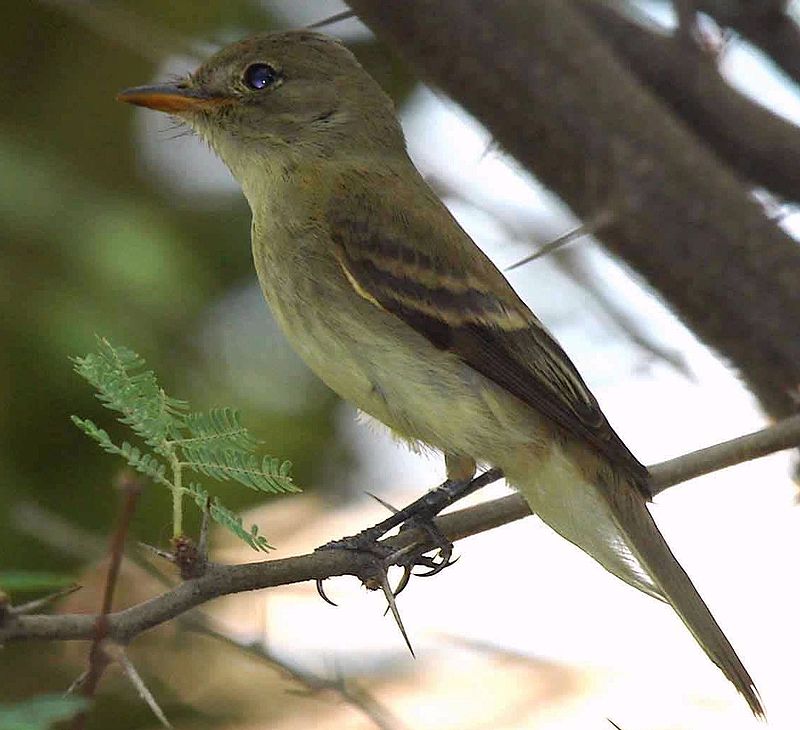
The Willow flycatcher is a small insect-eating bird belonging to the tyrant flycatcher family. It migrates from its neotropical home during summer months and breeds in North America, with three of its four subspecies found in California.
These birds can be difficult to identify by sight but their songs are distinctive enough for biologists to tell them apart easily.
The male willow flycatcher has an olive back, white underparts and yellowish legs while females have duller colors overall such as grey on the head instead of olive green.
They prefer open woodlands or river edges where they feed mostly on insects like flies, beetles and caterpillars which makes it beneficial for controlling pest populations near agricultural areas too.Scientific classification:
| Kingdom | Animalia |
| Phylum | Chordata |
| Class | Aves |
| Order | Passeriformes |
| Family | Tyrannidae |
| Genus | Empidonax |
| Species | E. traillii |
Also Featured In: Birds that Live in Yosemite National Park, Gray Birds that You’ll Find in Minnesota
4. Great Crested Flycatcher
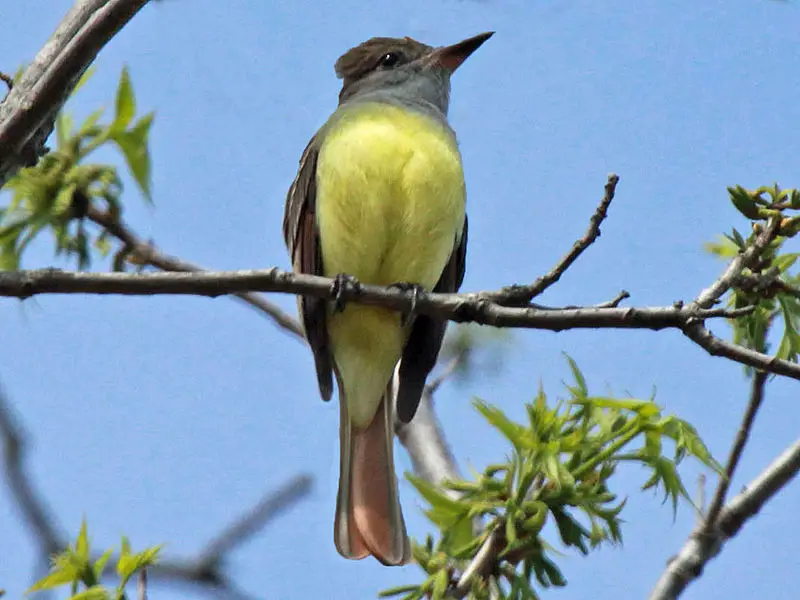
The Great crested flycatcher is a large insect-eating bird belonging to the tyrant flycatcher family.
It has an extensive range across North America, inhabiting most of the eastern and midwestern parts of the continent. They are usually found in treetops but rarely come down to ground level.
Adults measure around 7 inches long with wingspans up to 12 inches wide and they have grayish brown heads with yellow throats and upper breasts while their backs tend to be olive green or grey mixed with black spots on some species.
Their tails are broad, reaching lengths up 8 inches long, often being cocked when perched as they search for insects below them in trees or shrubs.
The males also possess a crest which adds even more splash of colour during mating season.Scientific classification:
| Kingdom | Animalia |
| Phylum | Chordata |
| Class | Aves |
| Order | Passeriformes |
| Family | Tyrannidae |
| Genus | Myiarchus |
| Species | M. crinitus |
Also Featured In: Yellow Birds You’ll Find in Minnesota, Yellow Georgia Birds
5. Least Flycatcher
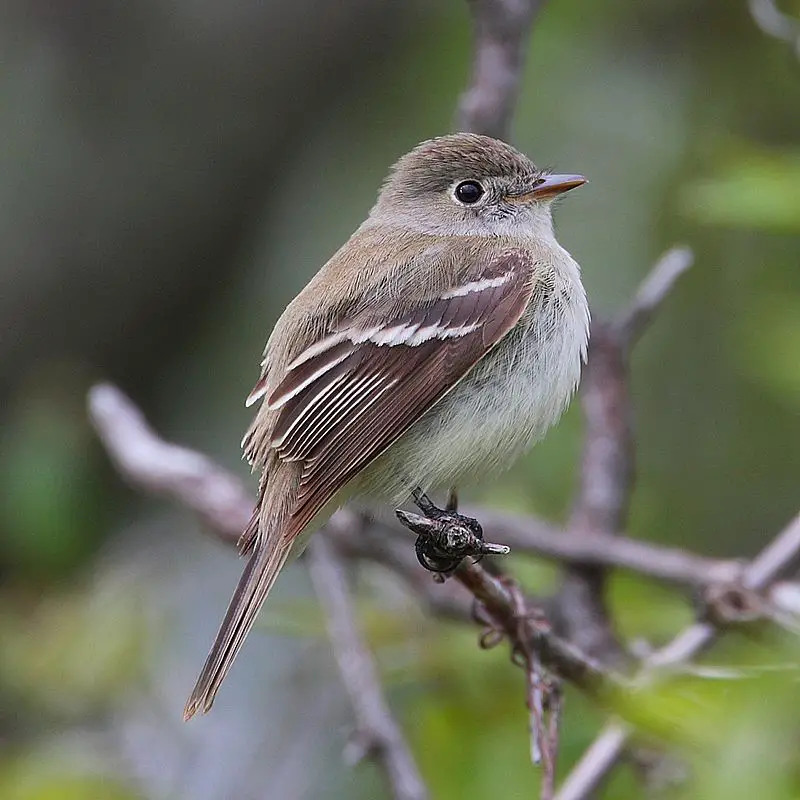
The Least Flycatcher is a small insect-eating bird native to eastern North America. It is the smallest member of its genus, Empidonax and can be easily identified by its grayish upperparts, pale yellow underparts, white eye ring and short bill.
Its call has been described as “chebec” or “chebecker”. Until recently, it was thought that Hammond’s flycatcher was its closest relative due to similar songs and appearances; however mitochondrial DNA analysis suggests otherwise.
The least flycatcher feeds mainly on flying insects which are caught in midair with rapid sallies from an exposed perch.
During breeding season they construct cup-shaped nests out of twigs near water sources such as ponds or lakes where adults tend their young until late summer when the fledglings disperse for winter migration southward into Central America and northern South America regions.Scientific classification:
| Kingdom | Animalia |
| Phylum | Chordata |
| Class | Aves |
| Order | Passeriformes |
| Family | Tyrannidae |
| Genus | Empidonax |
| Species | E. minimus |
6. Gray Flycatcher
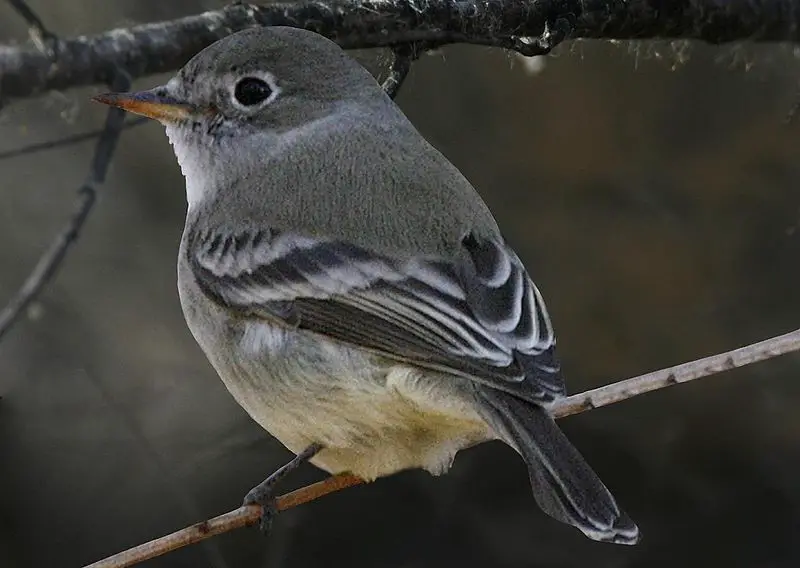
The Gray Flycatcher is a small, insect-eating bird found in the arid regions of western North America. It particularly inhabits sagebrush steppes, pinyon-juniper woodlands and ponderosa pine forests.
This species forages both on the ground and in trees for food such as insects, spiders and other invertebrates. The male has an olive back with grey underparts while female have brownish backs instead of olive.
They also have white wingbars which are easily visible when they fly away from their perch to catch prey or avoid predators.
During breeding season they sing a series of simple phrases that sound like “tseer” or “tsweeep” alternating between them rapidly several times before ending abruptly at its highest pitch.Scientific classification:
| Kingdom | Animalia |
| Phylum | Chordata |
| Class | Aves |
| Order | Passeriformes |
| Family | Tyrannidae |
| Genus | Empidonax |
| Species | E. wrightii |
7. Acadian Flycatcher
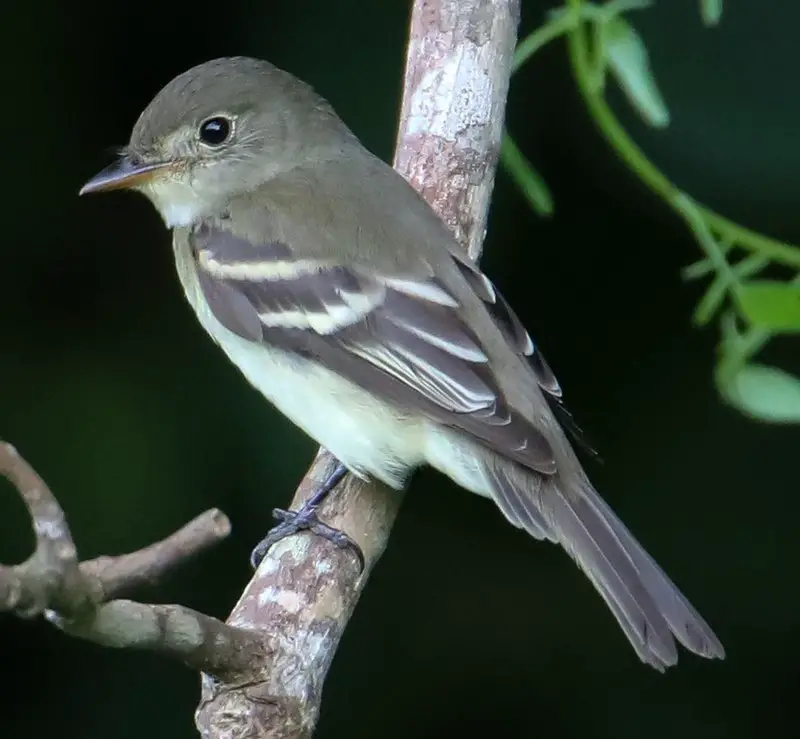
The Acadian flycatcher is a small insect-eating bird from the tyrant flycatcher family. It has an olive upper body and darker wings and tail, with whitish underparts.
The breast has a light wash of olive colouring which stands out against its white eye ring, white wing bars and wide bill. The top part of its beak is dark while the bottom half is yellowish in hue.
When singing it produces an explosive peet-sa sound that can be heard over long distances in wooded areas during breeding season.
Its diet consists mainly of insects found near water sources like lakes or rivers as well as forest edges where they are more abundant.Scientific classification:
| Kingdom | Animalia |
| Phylum | Chordata |
| Class | Aves |
| Order | Passeriformes |
| Family | Tyrannidae |
| Genus | Empidonax |
| Species | E. virescens |
8. Pacific-Slope Flycatcher
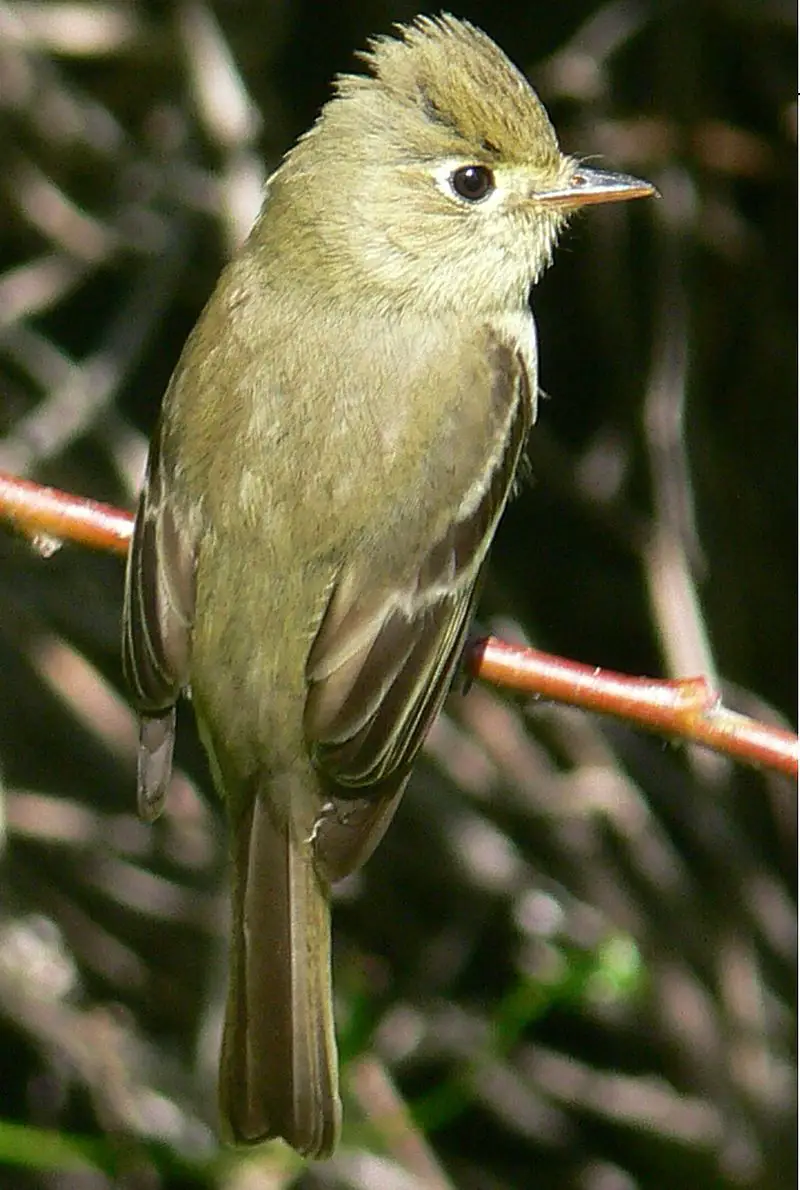
The Pacific-slope flycatcher is a small insectivorous bird of the family Tyrannidae, native to coastal regions in western North America.
It ranges from British Columbia and southern Alaska down to the Gulf of California and beyond, as far south as Central America.
The adult male has olive-green upperparts with yellowish underparts while females tend to be more dull and brownish overall. This species can also be distinguished by its clear white wing bars on both sides of each wing.
They are commonly found near streams or rivers around wooded areas foraging for insects such as flies, mosquitoes, moths and beetles which make up their diet along with some berries when available during certain times of year.
Its presence can often alert other birds that it may have spotted potential predators nearby due to its loud ‘chip’ call typically made when alarmed or agitated.Scientific classification:
| Kingdom | Animalia |
| Phylum | Chordata |
| Class | Aves |
| Order | Passeriformes |
| Family | Tyrannidae |
| Genus | Empidonax |
| Species | E. difficilis |
9. Yellow-Bellied Flycatcher
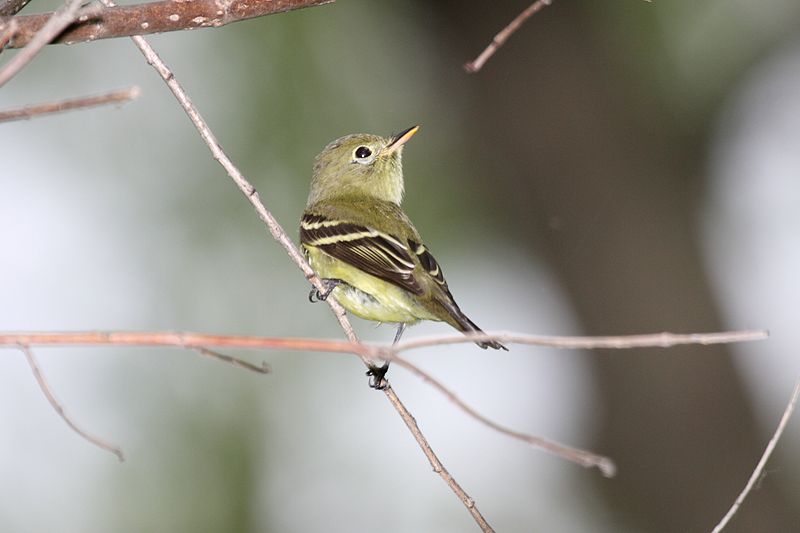
The Yellow-bellied Flycatcher is a small bird of the tyrant flycatcher family. It has greenish upperparts and yellowish underparts, with a dusky wash on its chest.
Its distinctive feature is the white or yellow eye ring that lacks any teardrop projection – setting it apart from other similar species in its family.
This insectivorous bird can be found in open habitats such as forest edges and woodland clearings across much of North America during summer months, when they migrate south to warmer areas for wintertime nesting.
They feed mainly on insects caught by sallying out after them from an exposed perch, but also take fruit occasionally at times of year when there are fewer flying insect prey available to eat.Scientific classification:
| Kingdom | Animalia |
| Phylum | Chordata |
| Class | Aves |
| Order | Passeriformes |
| Family | Tyrannidae |
| Genus | Empidonax |
| Species | E. flaviventris |
Also Featured In: Birds that Live in Newfoundland and Labrador, Mountain Birds You Should Know
10. Olive-Sided Flycatcher
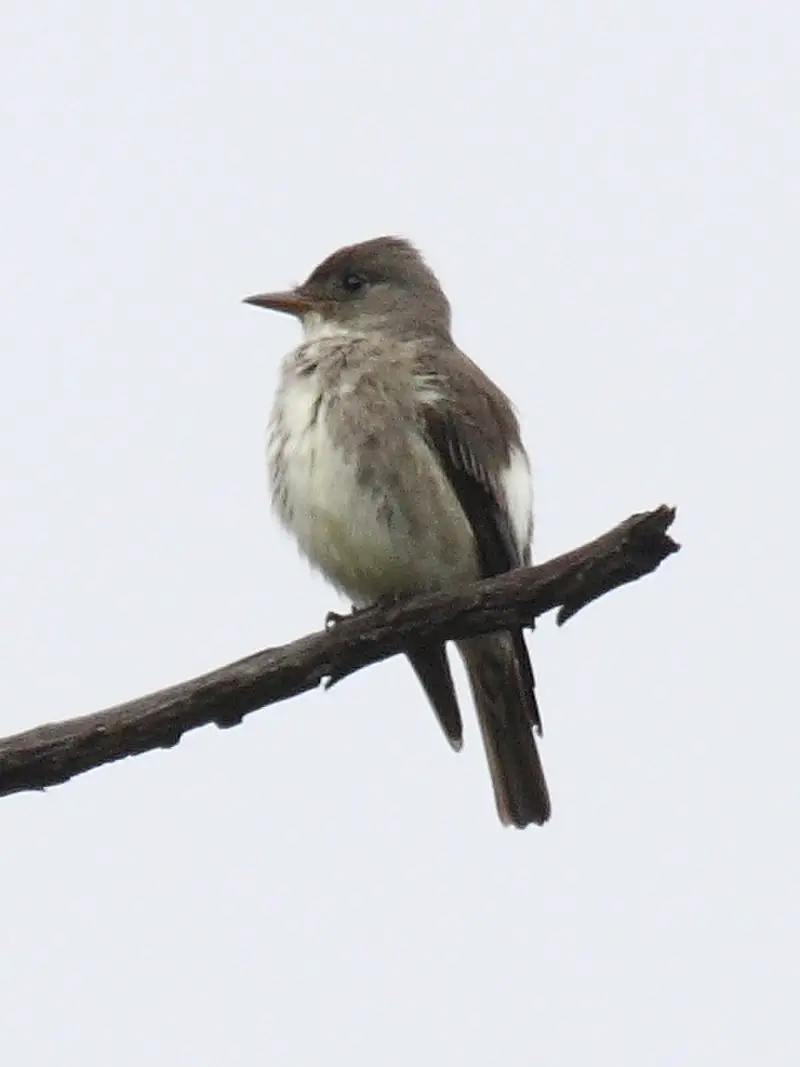
The Olive-sided Flycatcher is a small to medium size passerine bird in the family Tyrannidae.
It migrates from South America to North America for breeding every summer and preys on flying insects while agilely gliding through the air.
This species has been considered near threatened globally by IUCN since 2016 due to population declines caused by habitat loss, deforestation, and fragmentation of their nesting grounds.
Conservation efforts are underway with research being done on this species’ behaviour and habits so that suitable habitats can be created or maintained for them to survive long term.Scientific classification:
| Kingdom | Animalia |
| Phylum | Chordata |
| Class | Aves |
| Order | Passeriformes |
| Family | Tyrannidae |
| Genus | Contopus |
| Species | C. cooperi |
Also Featured In: Birds of Nova Scotia, Common Northwest Territories Birds
11. Cordilleran Flycatcher
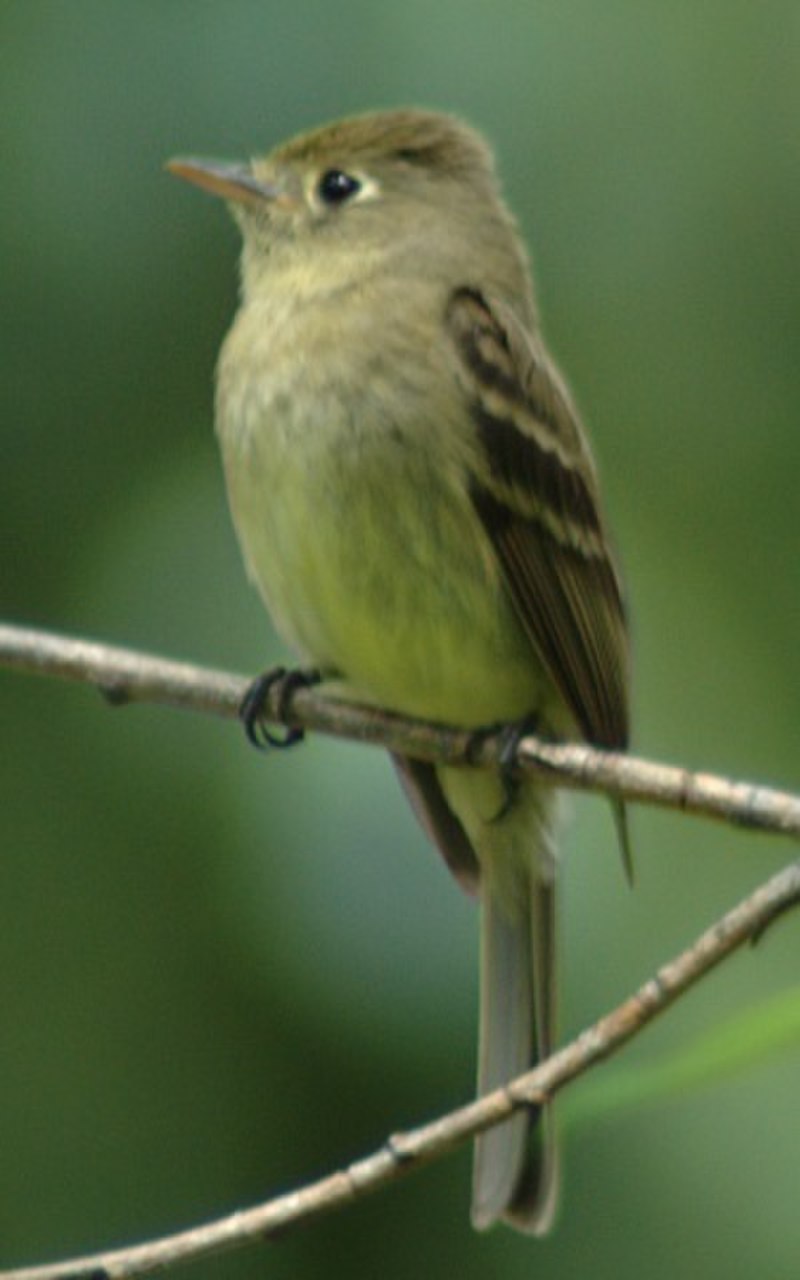
The Cordilleran flycatcher is a small, insect-eating bird that typically measures between 13 and 17 cm in length.
It has olive-gray upperparts with darker wings and tail, as well as yellowish underparts which boast an attractive teardrop-shaped white eye ring.
Its bill is quite small while its wings feature prominent white wing bars. This type of flycatcher also features a short tail to complete the look.
The species looks similar to other Empidonax Flycatchers but can be easily identified by their distinct markings on both the upper- and lower parts of their bodies combined with their unique eye rings.
Although not used for flight much due to its size, it still provides great joy when spotted out in nature.Scientific classification:
| Kingdom | Animalia |
| Phylum | Chordata |
| Class | Aves |
| Order | Passeriformes |
| Family | Tyrannidae |
| Genus | Empidonax |
| Species | E. occidentalis |
12. Ash-Throated Flycatcher
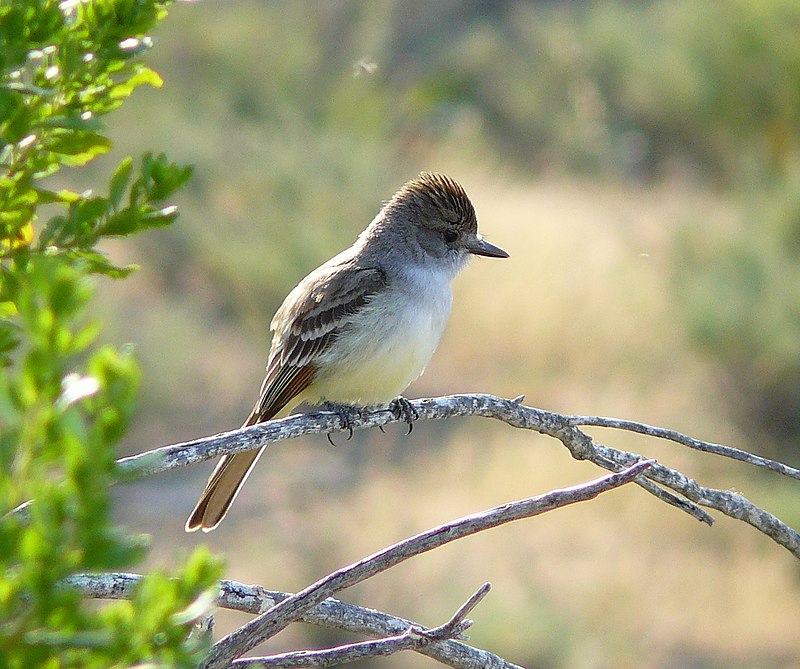
The Ash-throated Flycatcher is a small passerine bird that belongs to the tyrant flycatcher family.
First discovered in 1851 by George Newbold Lawrence, it was initially given the scientific name Tyrannula cinerascens and mistakenly described again as Tyrannula mexicanus.
This species of flycatchers is found primarily in western Texas but can be seen all over America including California, Arizona and Utah.
They have an ash gray head with yellowish underparts which gives them their unique coloration.
The back part of their heads are darker brown while they possess two white wingbars on either side of their wings.
They feed mainly on insects such as ants and beetles which they hunt from low perches or even take directly from foliage.
Their call consists of a loud “chek” sound followed by several high pitched notes at once making for quite a captivating singing performance.Scientific classification:
| Kingdom | Animalia |
| Phylum | Chordata |
| Class | Aves |
| Order | Passeriformes |
| Family | Tyrannidae |
| Genus | Myiarchus |
| Species | M. cinerascens |
Also Featured In: British Columbian Birds, Birds that Live in Morelos
13. Hammond’s Flycatcher
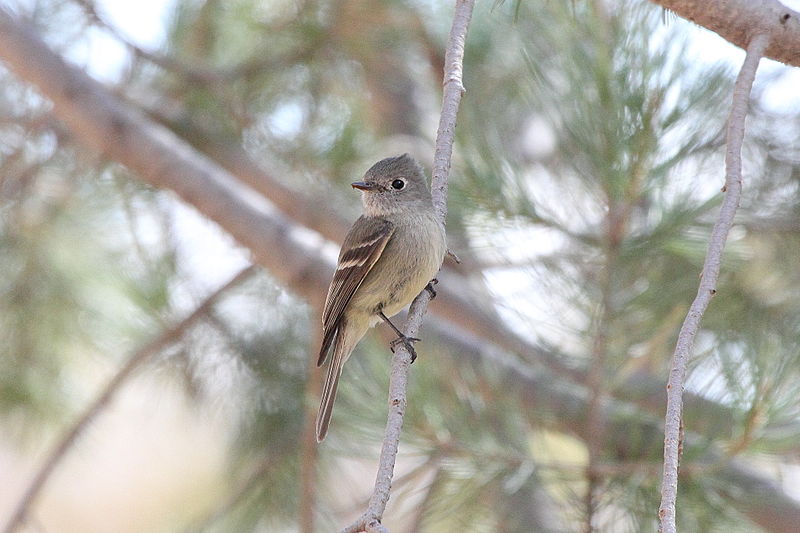
Hammond’s flycatcher is a small insectivorous bird found in the coniferous and mixed forests of Western North America.
It was named after William Alexander Hammond, who served as Surgeon General of the US Army and collected bird specimens for Spencer Fullerton Baird.
Adults measure between 12-14 cm long (4.7-5.5 inches) with a wingspan around 21cm (8 inches).
They have gray heads with yellowish eyestripe, olive backs and whitish bellies; their tails are dark on top and lighter underneath but often barred by black feathers across it widthwise.
Males possess rusty red throats which can be seen when they sing from an open perch to advertise mating opportunities or defend territories against rival birds during breeding season – usually occurring April through May or June depending upon location.Scientific classification:
| Kingdom | Animalia |
| Phylum | Chordata |
| Class | Aves |
| Order | Passeriformes |
| Family | Tyrannidae |
| Genus | Empidonax |
| Species | E. hammondii |
Also Featured In: Birds that Found in the Yellowstone ,
14. Eastern Wood Pewee
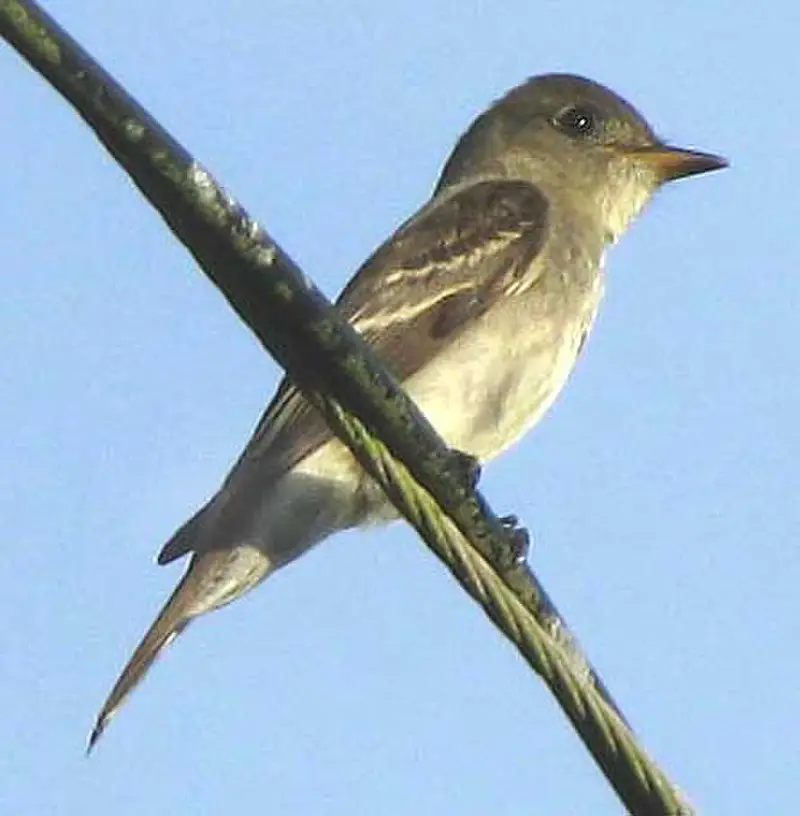
The Eastern Wood Pewee (Contopus virens) is an iconic bird of North America, easily identified by its distinctive call.
It was formerly considered a single species with the Western Wood Pewee until Mathurin Jacques Brisson included it in his 1760 description as two distinct birds.
The Eastern and Western varieties share almost identical appearances but can be differentiated most clearly through their calls – the former’s being more musical with higher pitched notes than that of its counterpart.
Its diet consists mainly of insects caught mid-flight or from foliage perches; however, it will also consume some fruits during breeding season to supplement this nutrition.
Overall, they make a beautiful addition to any backyard habitat.Scientific classification:
| Kingdom | Animalia |
| Phylum | Chordata |
| Class | Aves |
| Order | Passeriformes |
| Family | Tyrannidae |
| Genus | Contopus |
| Species | C. virens |
Also Featured In: Small Kentucky Birds, Small Birds Of Illinois
15. Eastern Phoebe
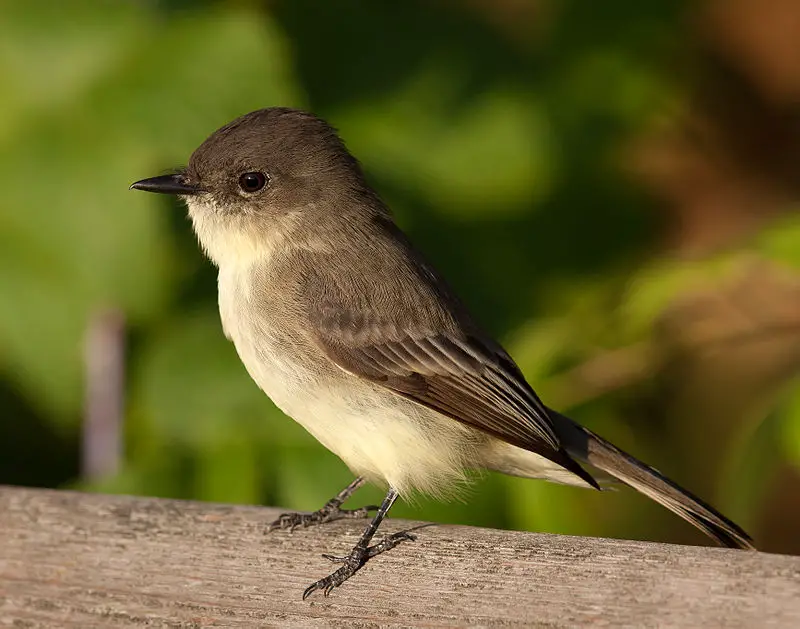
The Eastern Phoebe is a small passerine bird belonging to the genus Sayornis. It gets its name from Charles Lucien Bonaparte’s Muscicapa saya, and Ancient Greek ornis meaning “bird”.
The species’ alternative name ‘Phoebe’ comes from the Roman moon-goddess Diana, but also has been said to imitate their call.
Measuring up to 16 cm in length with a wingspan of 25–30 cm, they have grayish brown upperparts and pale underparts.
They are found near streams, woodlands and open fields where they hunt for insects such as flies, bees wasps etc., often catching them midair or by sallying out from perchs like branches or fences.
These birds make shallow cup nests made of grasses lined with mud which are built on cliffs ledges walls buildings bridges trees etc..
All in all this beautiful little bird is an interesting addition wherever you find it.Scientific classification:
| Kingdom | Animalia |
| Phylum | Chordata |
| Class | Aves |
| Order | Passeriformes |
| Family | Tyrannidae |
| Genus | Sayornis |
| Species | S. phoebe |
16. Brown-Crested Flycatcher
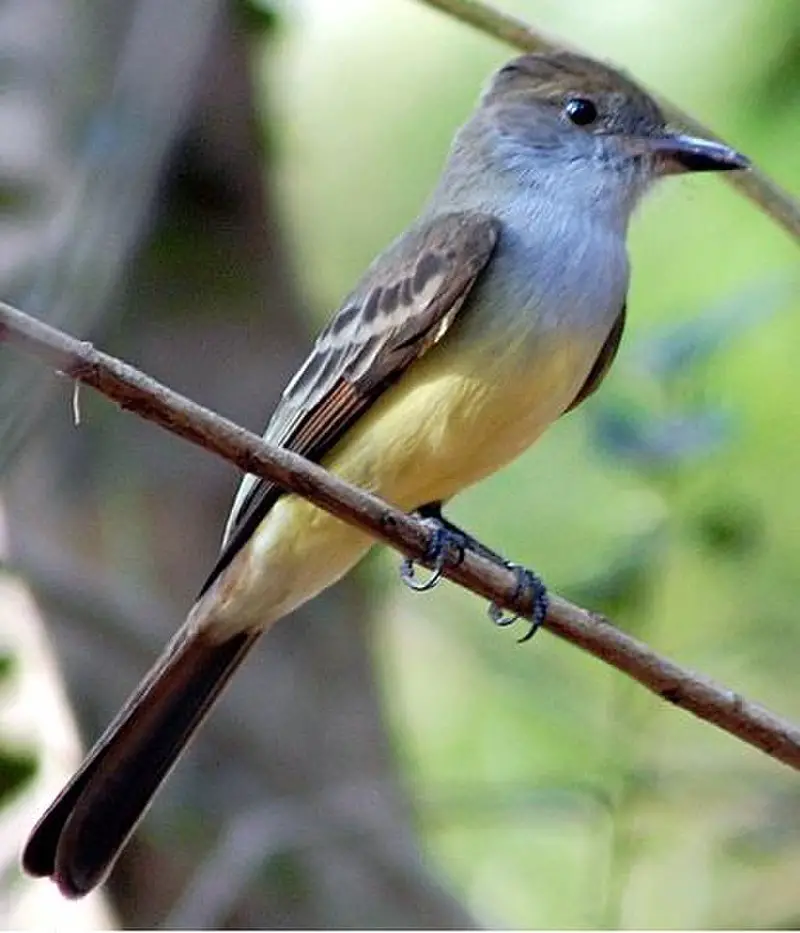
The Brown-crested Flycatcher is a passerine bird belonging to the tyrant flycatcher family. It’s one of the largest species in its genus, ranging from 18 to 24 cm in length and varying greatly in size across their range with those foundin M. t. tyrannulus typically being smaller than others like M. t magister.
These birds have brown upperparts and wings while they sport yellow undersides along with white bellies and throats as well as black tails and blueish purple bills which make them instantly recognisable among other types of birds around them.
They are also known for their loud calls that sound similar to “tek-tekk” or even “preeeit”.Scientific classification:
| Kingdom | Animalia |
| Phylum | Chordata |
| Class | Aves |
| Order | Passeriformes |
| Family | Tyrannidae |
| Genus | Myiarchus |
| Species | M. tyrannulus |
Also Featured In: Birds You’ll Find in Sonoran,
17. Scissor-Tailed Flycatcher
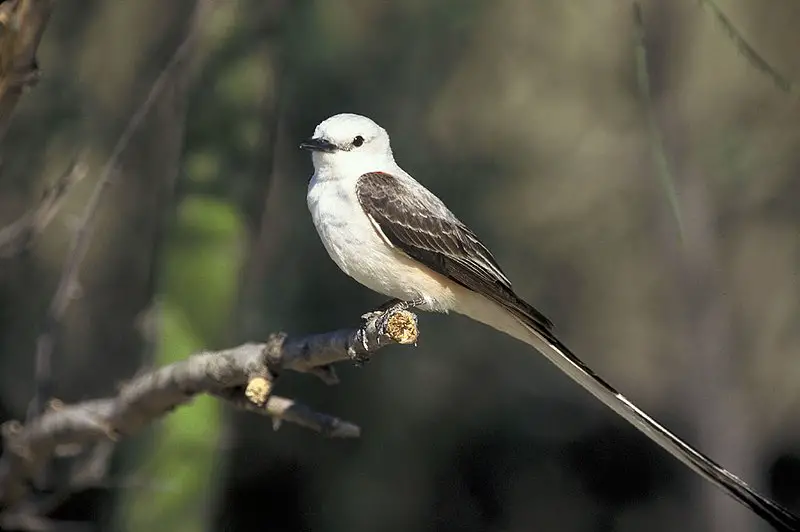
The scissor-tailed flycatcher is a beautiful bird, belonging to the Tyrannus genus of kingbirds. It is known by various names such as Texas Bird-of Paradise and Swallow-tailed Flycatcher.
This insectivorous bird has an impressive long tail which it uses for courtship displays and aerial acrobatics – making it quite the showstopper.
Its range includes North America and Central South American regions where they breed in open fields, pastures or grasslands with scattered trees available.
They feed on insects like dragonflies, damselflies and small moths that they catch while gliding through air gracefully with their wings spread apart wide.
To watch this amazing creature soar freely over its habitat would be nothing short of breathtaking.Scientific classification:
| Kingdom | Animalia |
| Phylum | Chordata |
| Class | Aves |
| Order | Passeriformes |
| Family | Tyrannidae |
| Genus | Tyrannus |
| Species | T. forficatus |
Also Featured In: Birds You’ll Find in South Texas , Summer Birds that Live around Us
18. Western Wood Pewee
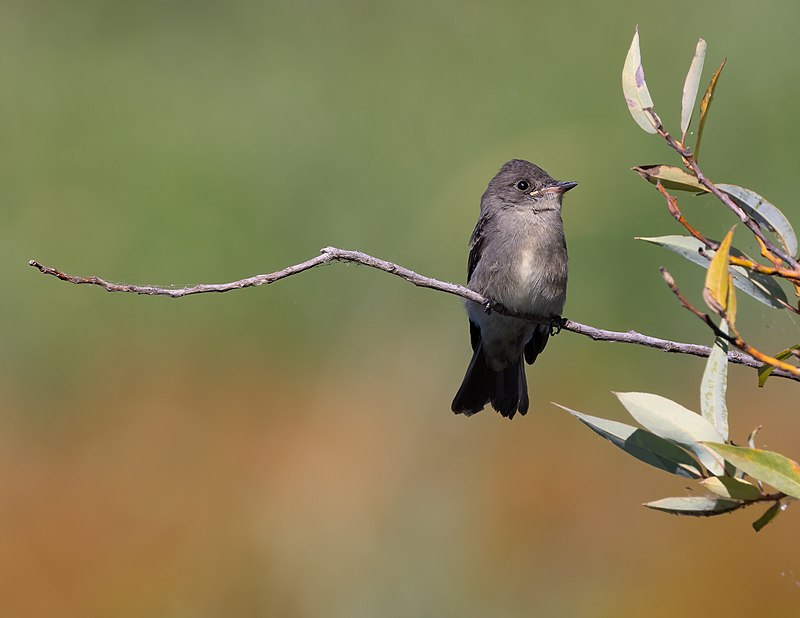
The Western Wood Pewee is a small tyrant flycatcher native to North America. It has gray-olive upperparts and light underparts with an olive wash on the breast, along with two wing bars and a dark bill with yellow at its base.
This bird was formerly considered one species together with the Eastern Wood Pewee; however they are now classified separately due to certain differences in size as well as vocalizations.
The call of this species consists of several short notes followed by some higher pitched notes that sound like “pee-a-wee” or “peeu”.
Its diet consists mostly of insects, which it captures midair while perched atop trees or shrubs.
During breeding season, these birds form monogamous pairs and build nests from cobwebs lined inside cup shaped structures made out of grasses near water sources such as streams or ponds for easy access to food for their young ones.Scientific classification:
| Kingdom | Animalia |
| Phylum | Chordata |
| Class | Aves |
| Order | Passeriformes |
| Family | Tyrannidae |
| Genus | Contopus |
| Species | C. sordidulus |
19. Eastern Kingbird
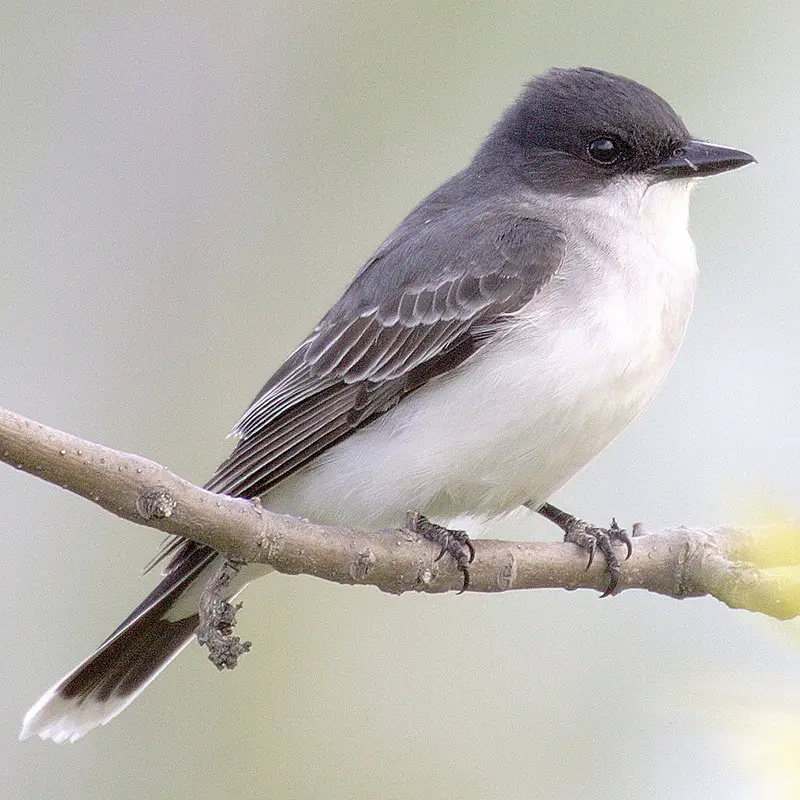
The Eastern kingbird is an impressive large grey bird, with a white underbelly and pointed wings. It can be seen perched atop trees or bushes in open areas while foraging for insects.
This species of tyrant flycatcher breeds across much of North America during the spring and summer months before migrating southwards come wintertime.
During this time, they have been known to travel as far south as Central and South America.
These birds are particularly territorial when nesting; having been observed chasing off even larger animals such as hawks away from their nests. A truly remarkable sight to behold.Scientific classification:
| Kingdom | Animalia |
| Phylum | Chordata |
| Class | Aves |
| Order | Passeriformes |
| Family | Tyrannidae |
| Genus | Tyrannus |
| Species | T. tyrannus |
Also Featured In: Birds that You’ll Find in Puerto Rico, Common Birds in Saskatchewan
20. Say’s Phoebe
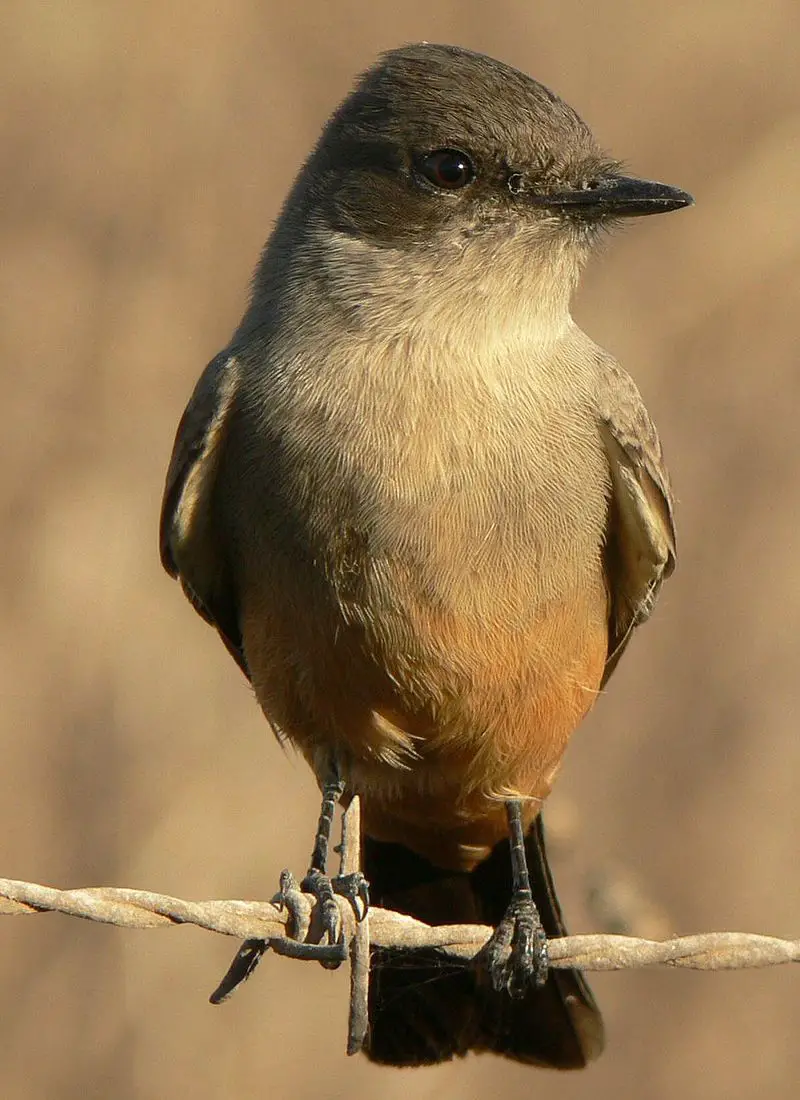
Say’s phoebe is a bird from the tyrant flycatcher family native to western North America. It was named for American naturalist Thomas Say, who first described it in 1825.
This species prefers dry and desolate areas as its habitat. Its brown plumage with whitish underside makes them quite easy to spot among other birds of similar size.
They are also known for their distinctive call; “phoe-bee” which they repeat often throughout the day while perched on fence posts or tree branches scanning their surroundings looking out for food sources such as flying insects, small frogs and lizards etc..
Their nests are made up of plant materials like grasses lined with hair or feathers placed inside cavities either under overhangs or in abandoned structures like barns and sheds providing ample protection against predators such as hawks and foxes.Scientific classification:
| Kingdom | Animalia |
| Phylum | Chordata |
| Class | Aves |
| Order | Passeriformes |
| Family | Tyrannidae |
| Genus | Sayornis |
| Species | S. saya |
Also Featured In: Phoenix Birds You Should Know, Birds You’ll Find in the Rio Grande Valley
21. Western Kingbird
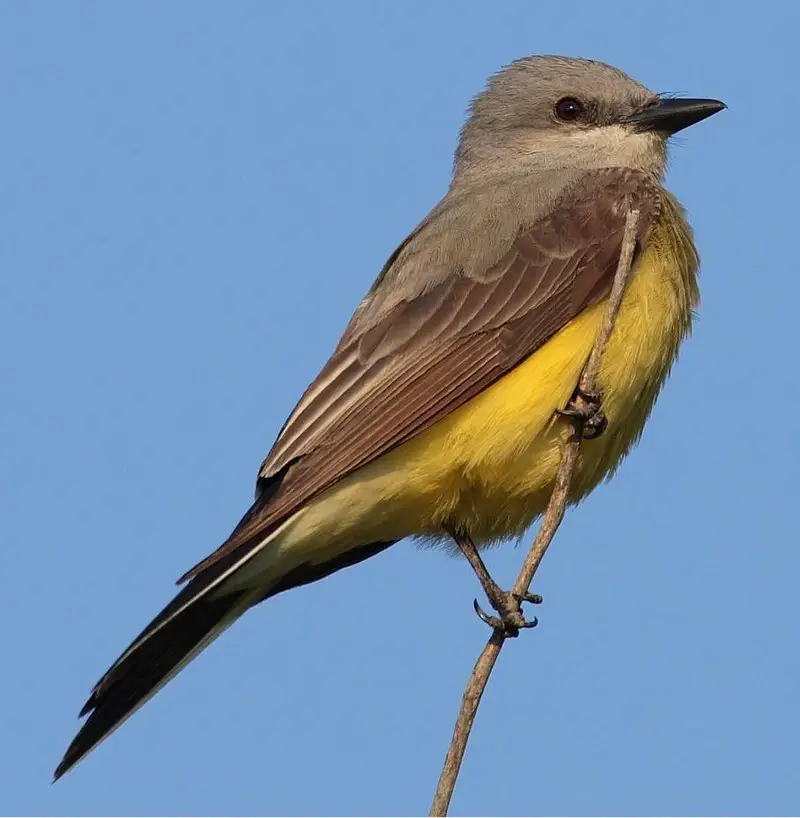
The Western kingbird is a large tyrant flycatcher native to western North America. It has striking plumage, with gray and yellow feathers tinged with crimson during courtship or when defending territory from intruders.
As is characteristic of its kind, the Western Kingbird exhibits highly territorial behavior towards other birds in its area.
They are found as far south as Mexico, inhabiting open habitats near bodies of water such as rivers and lakes.
While their primary diet consists of insects like bees and flies that they catch mid-flight, it also includes fruit for variety during winter months.
The species have recently seen an increase in population due to conservation efforts which aim to protect these beautiful creatures.Scientific classification:
| Kingdom | Animalia |
| Phylum | Chordata |
| Class | Aves |
| Order | Passeriformes |
| Family | Tyrannidae |
| Genus | Tyrannus |
| Species | T. verticalis |
Also Featured In: Birds that Live in the Deserts, Common Southern Californian Birds
22. Black Phoebe
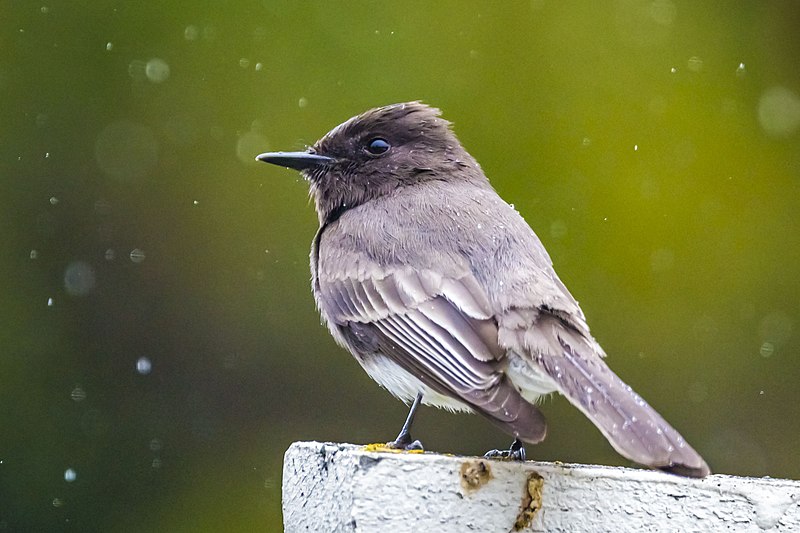
The black phoebe is a beautiful passerine bird belonging to the tyrant-flycatcher family. It breeds from southwest Oregon and California south through Central and South America, where it can be found year-round.
However, its northern populations tend to migrate seasonally in some areas. Six subspecies of this species have been identified so far: two are occasional visitors while the others are more common residents in their range.
The adult has mainly dark grey upperparts with a white belly; juveniles may show brownish tones instead of grey ones on their back.
Its main diet consists of insects which it catches by hovering over water or flying out after them from perches near rivers or streams – hence why they’re often seen around these places.Scientific classification:
| Kingdom | Animalia |
| Phylum | Chordata |
| Class | Aves |
| Order | Passeriformes |
| Family | Tyrannidae |
| Genus | Sayornis |
| Species | S. nigricans |
Also Featured In: Birds Live Near San Diego, Birds Commonly Found in Northern California
23. Great Kiskadee
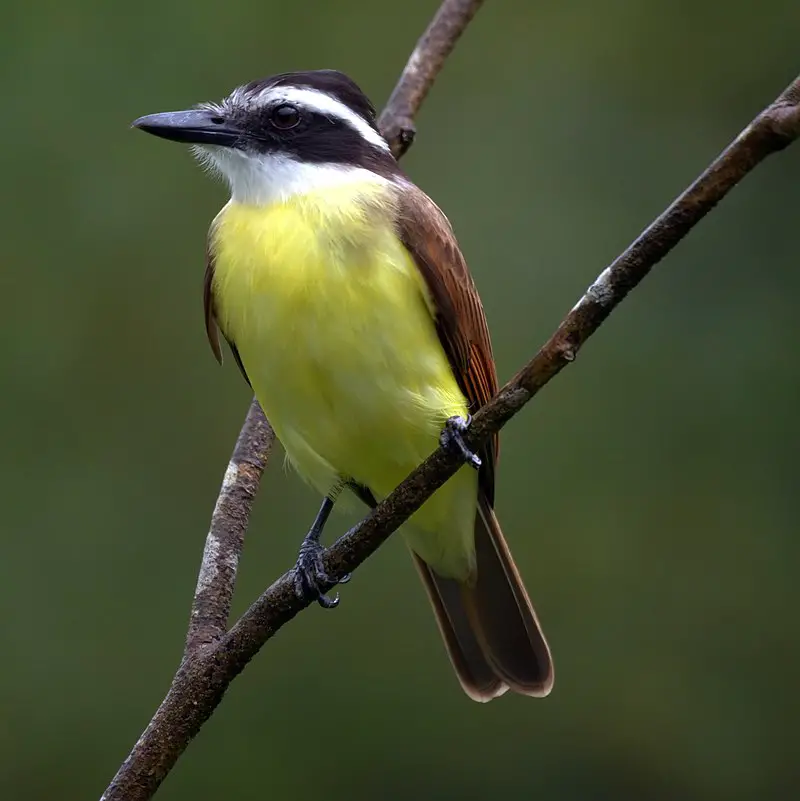
The Great Kiskadee is a passerine bird belonging to the Tyrant Flycatcher family.
It has an unmistakable yellow and black plumage, making it easily recognizable in its native habitats of Belize, Texas, Argentina and Brazil where it is known as Bem-te-vi or Benteveo respectively.
The species inhabits open woodland with some tall trees such as cultivation areas and other places surrounding human dwellings.
This adaptable bird feeds mainly on insects but also consumes fruit for energy when needed.
Its call resembles laughter which adds to its charm among avid nature watchers who are always delighted by their presence.
A unique feature that sets this species apart from others is that they can imitate songs of other birds accurately too.Scientific classification:
| Kingdom | Animalia |
| Phylum | Chordata |
| Class | Aves |
| Order | Passeriformes |
| Family | Tyrannidae |
| Genus | Pitangus Swainson, 1827 |
| Species | P. sulphuratus |
24. Buff-Breasted Flycatcher
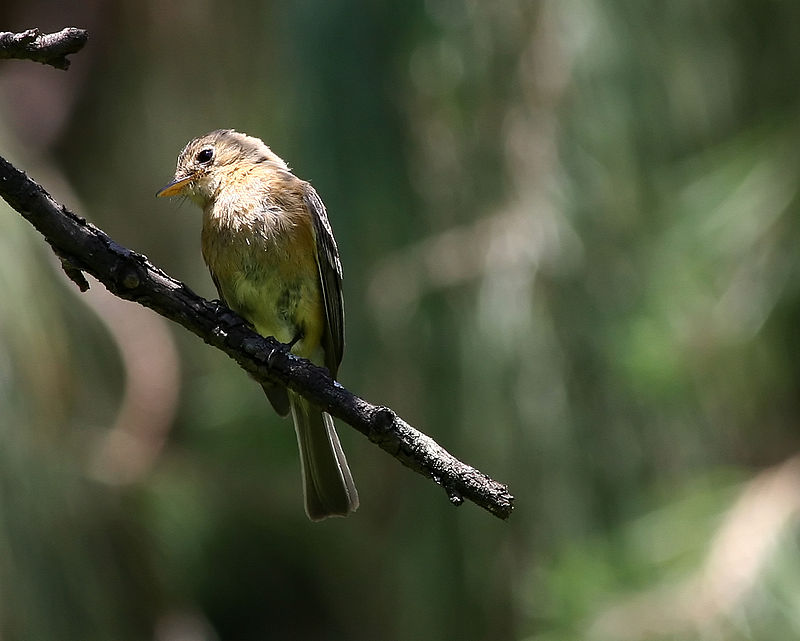
The Buff-breasted Flycatcher is a small insectivorous bird, measuring between 11.5 and 13 cm in size. It has an olive grey upper body with darker coloration on the wings and tail, as well as white eye rings, wing bars, a short bill and tail.
Its most distinguishing feature however is its chest which is washed with a strong yellowish buff colouring that really sets it apart from other species of Empidonax flycatchers.
This little bird can usually be found perched atop low branches or shrubs searching for prey such as flying insects like beetles or moths to feed upon during warmer months when food is plentiful.Scientific classification:
| Kingdom | Animalia |
| Phylum | Chordata |
| Class | Aves |
| Order | Passeriformes |
| Family | Tyrannidae |
| Genus | Empidonax |
| Species | E. fulvifrons |
Also Featured In: Common Birds of Mexico City,
25. Scarlet Flycatcher
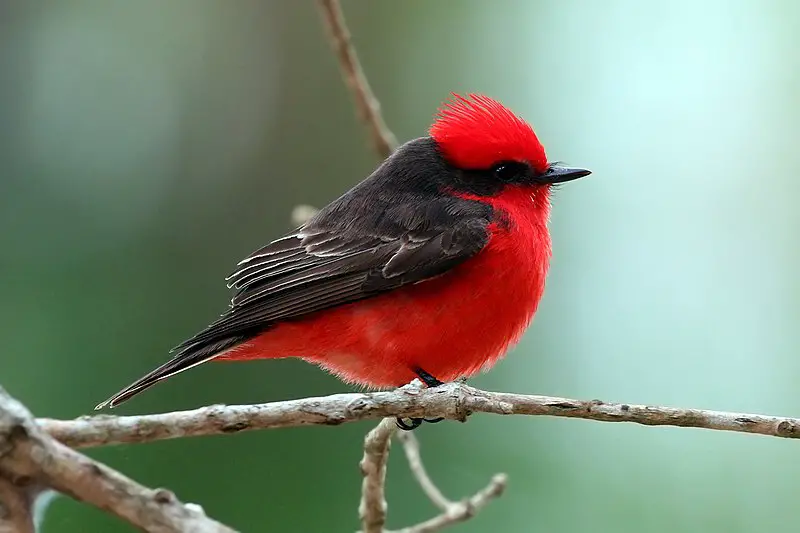
The Scarlet Flycatcher, also referred to as the Austrial Vermilion Flycatcher, is an eye-catching bird found in southeastern Bolivia and Brazil, Paraguay to Argentina and Uruguay.
It belongs to a group of flycatchers closely related with the vermilion flcyatcher. This species has bright orange feathers on its face and chest combined with black wings making it unmistakable when seen up close.
Its diet consists of insects which they catch while flying low over open terrain like creeks or marshes using their agile flight capabilities.
While some taxonomic authorities recognize this bird as a separate species from the Vermillion Flyctacher, others still consider it simply a subspecies thereof.
Overall they are very beautiful birds that will add beauty wherever spotted.Scientific classification:
| Kingdom | Animalia |
| Phylum | Chordata |
| Class | Aves |
| Order | Passeriformes |
| Family | Tyrannidae |
| Genus | Pyrocephalus |
| Species | P. rubinus |
Also Featured In: Spiritual Birds, Red birds You’ll See in Arizona
26. Dusky-Capped Flycatcher
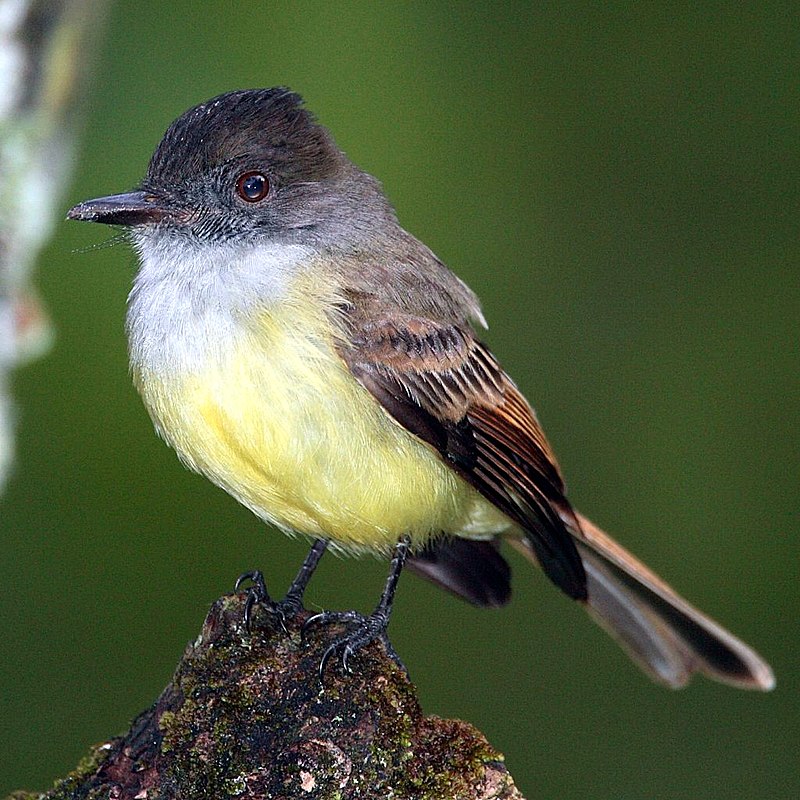
The Dusky-capped Flycatcher is a small, passerine bird belonging to the tyrant flycatcher family. It can be found in areas of semi-open woodland from southern Arizona and Texas southward to northern Argentina and Trinidad.
During winter months, American breeders retreat to Mexico while other parts remain resident year round. Adults are 18 cm long and have brownish olive upperparts with buffy underparts; they also feature dusky caps which give them their name.
This species has an active foraging style usually carried out high up in trees where it catches insects on the wing or gleans food from foliage.
The call consists of harsh chirps typically given when perched atop dead branches or tree tops. With its wide range across multiple countries this species is currently considered least concern by IUCN Red List due to stable population trends.Scientific classification:
| Kingdom | Animalia |
| Phylum | Chordata |
| Class | Aves |
| Order | Passeriformes |
| Family | Tyrannidae |
| Genus | Myiarchus |
| Species | M. tuberculifer |
Also Featured In: Cozumel Birds You Didn’t Know,
27. Tropical Kingbird
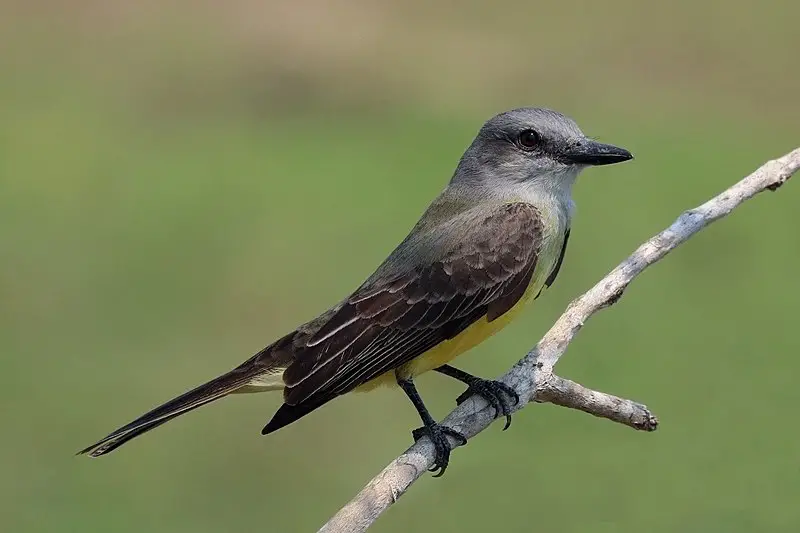
The Tropical Kingbird is an impressive bird, native to the Americas. It’s a large tyrant flycatcher that breeds in southern Arizona and Texas through Central America and down south as far as Argentina and Peru.
This species also lives on Trinidad & Tobago islands. During cold winter months, most of them migrate to warmer climates within its range.
They inhabit open areas such as fields or forests with scattered trees – but away from heavily wooded habitats.
In terms of diet, they mainly feed upon insects which are caught by hawking from perches or snatching up in flight; however it will occasionally eat fruits too.
The adult has grey-brown upperparts, darker wings edged with yellowish feathers plus a white breast band contrasting against pale orange underparts for both sexes.
A conspicuous black mask runs across their eyes completing this beautiful bird’s look.Scientific classification:
| Kingdom | Animalia |
| Phylum | Chordata |
| Class | Aves |
| Order | Passeriformes |
| Family | Tyrannidae |
| Genus | Tyrannus |
| Species | T. melancholicus |
28. Cassin’s Kingbird
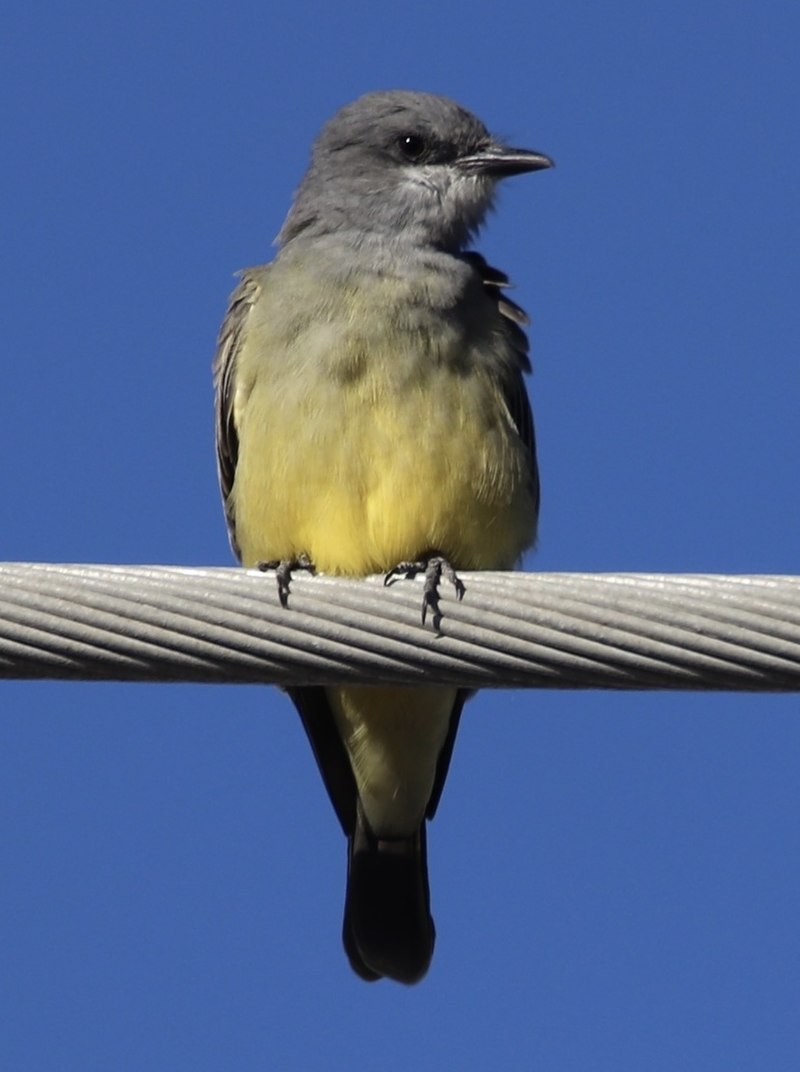
Cassin’s kingbird is a large tyrant flycatcher native to western North America. It was named in honor of the American ornithologist John Cassin and first described by English naturalist William John Swainson back in 1826, with its type locality being Temascaltepec, Mexico.
These birds are generally dark gray or brown on top with lighter underparts that have yellowish tints around the throat and belly region.
They also sport long tails which they often spread wide while perched atop branches or wires looking out for prey like insects as well as small reptiles or amphibians.
Their calls can be quite loud but usually consist of two syllables: “whee-er” or sometimes “whit-chew”.
In addition to their diet, Cassin’s Kingbirds defend territories against other species including hawks and crows during breeding season when they raise their young before migrating southward again come wintertime.Scientific classification:
| Kingdom | Animalia |
| Phylum | Chordata |
| Class | Aves |
| Order | Passeriformes |
| Family | Tyrannidae |
| Genus | Tyrannus |
| Species | T. vociferans |
Also Featured In: Orange County Birds You Need to See, Birds that Live around Santiago de Querétaro
29. European Pied Flycatcher
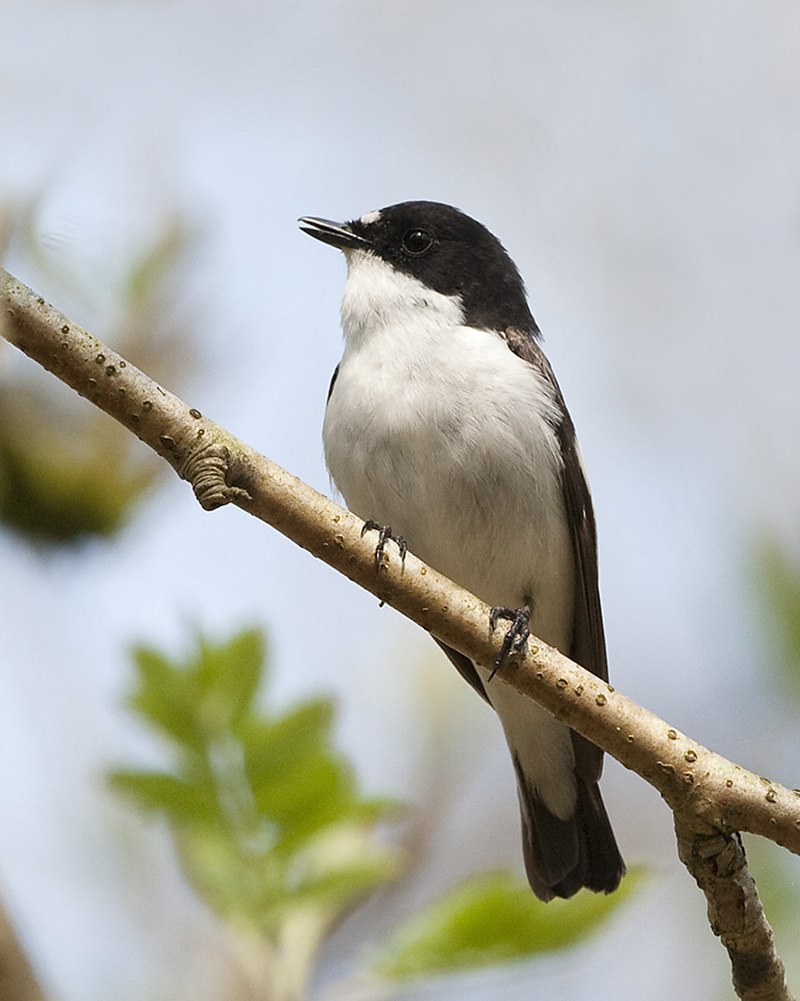
The European pied flycatcher is a small passerine bird belonging to the Old World flycatcher family.
It can generally be identified by its black and white plumage, with males possessing an orange breast patch during breeding season.
This species breeds in most of Europe and across the Western Palearctic before migrating south for winter, usually travelling to tropical Africa where it finds warmer climates more suited for migration.
During nesting season they build their nests inside tree holes or crevices high off the ground as protection from predators that may attack them while they are incubating their eggs.
The European pied flycatchers diet consists mainly of insects which makes them important members within ecosystems as insectivores who help regulate populations of potential crop pests like aphids or beetles.Scientific classification:
| Kingdom | Animalia |
| Phylum | Chordata |
| Class | Aves |
| Order | Passeriformes |
| Family | Muscicapidae |
| Genus | Ficedula |
| Species | F. hypoleuca |
30. Collared Flycatcher
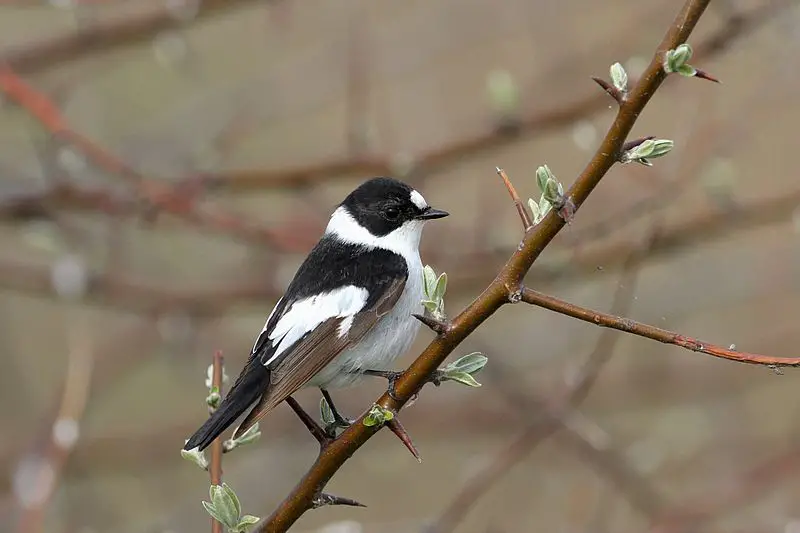
The Collared Flycatcher is a small passerine bird that belongs to the Old World flycatcher family.
It can be found breeding in southeastern Europe, as well as isolated populations on Gotland and Öland in Sweden’s Baltic Sea islands, Eastern France, the Balkan Peninsula and Ukraine.
During winter months it migrates southwards, spending time in subtropical regions such as northern Africa and parts of Asia.
The collared flycatcher has predominantly black-and-white plumage with a pale collar around its neck giving it its name – although some males have been known to display chestnut or reddish feathers during mating season.
Its diet mainly consists of insects which are caught by hawking from an exposed perch before being quickly swallowed whole.Scientific classification:
| Kingdom | Animalia |
| Phylum | Chordata |
| Class | Aves |
| Order | Passeriformes |
| Family | Muscicapidae |
| Genus | Ficedula |
| Species | F. albicollis |
Also Featured In: Common Slovakian Birds, Birds Commonly Found in Slovenia
31. Gray Kingbird
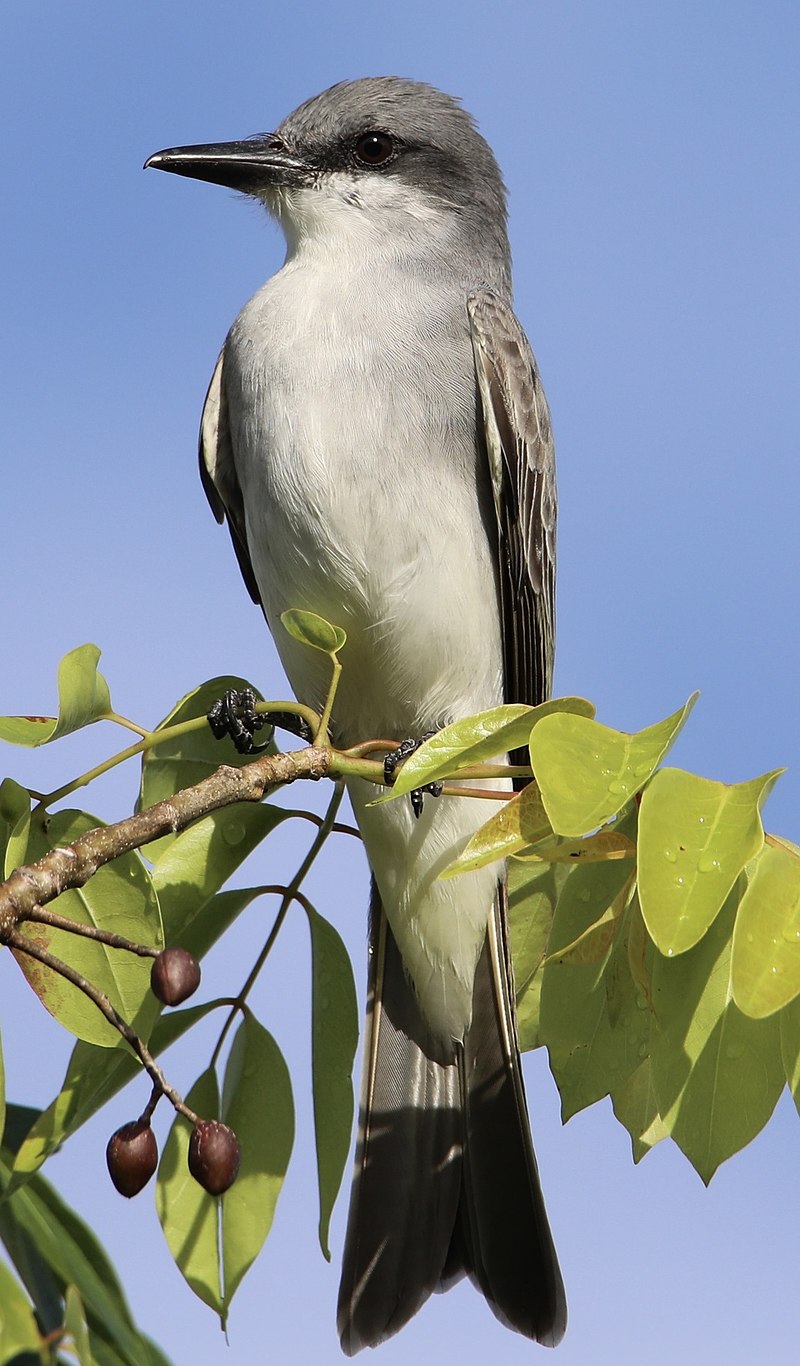
The Gray Kingbird is a species of tyrant flycatcher found in tall trees and shrubs, including the edges of savannas and marshes. It has gray feathers on its back with white underparts and blackish wings.
Its head is dark gray-brown or olive, while its tail is tipped with white. The Gray Kingbird builds flimsy cup nests from twigs in tree branches for their eggs to incubate safely until they hatch into chicks.
They feed mainly on insects such as moths, grasshoppers, beetles, crickets and caterpillars that can be caught midair when it swoops down from above like other kingbirds do.
This bird’s call consists of loud chirps which are often heard during mating season – making them an easily identifiable species within areas where they live.Scientific classification:
| Kingdom | Animalia |
| Phylum | Chordata |
| Class | Aves |
| Order | Passeriformes |
| Family | Tyrannidae |
| Genus | Tyrannus |
| Species | T. dominicensis |
32. Northern Beardless Tyrannulet
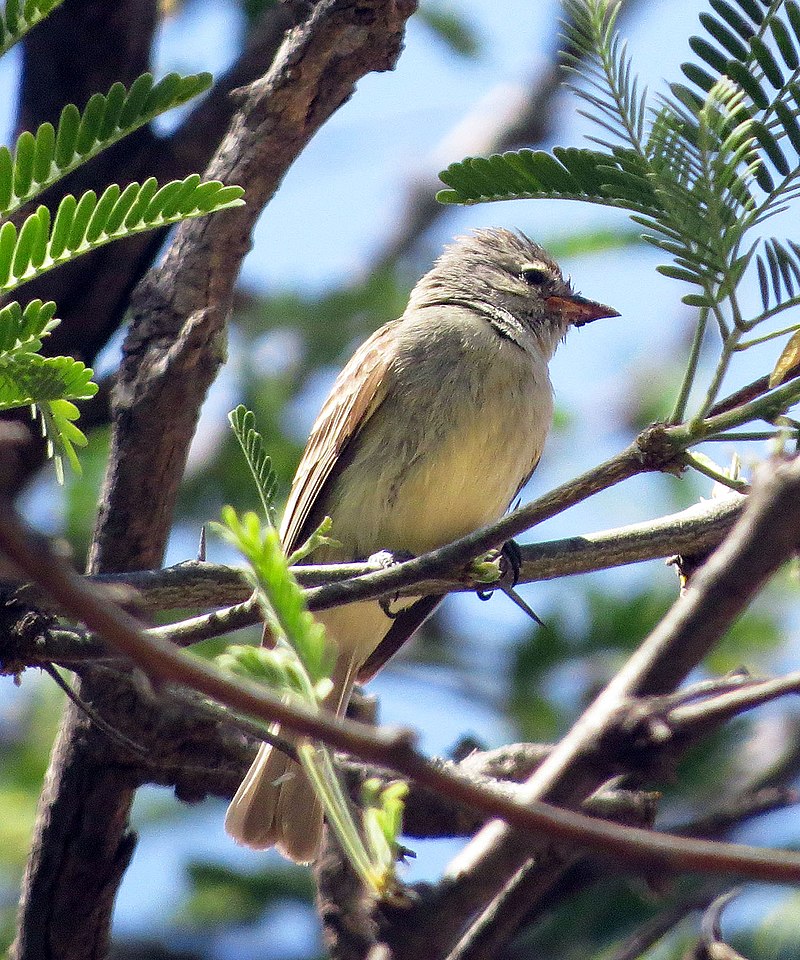
The Northern Beardless Tyrannulet is a small passerine bird found in the tyrant flycatcher family.
It inhabits light forests, cultivation and gardens with trees across southeasternmost Arizona and Texas of the United States through Mexico, Central America and up to northwestern Costa Rica.
The domed nests they build are made from plant fibre or leaves featuring a side entrance for easy access.
This species is known for its prominent yellowish-olive upperparts as well as white under parts with faint barring on sides.
Its tail feathers have black tips which gives it an extra touch of beauty.
These birds love to feed on insects such as grasshoppers, flies etc., although sometimes fruits can be seen in their diet too.
If you’re lucky enough you might spot them flitting between branches during mating season.Scientific classification:
| Kingdom | Animalia |
| Phylum | Chordata |
| Class | Aves |
| Order | Passeriformes |
| Family | Tyrannidae |
| Genus | Camptostoma |
| Species | C. imberbe |
33. Couch’s Kingbird
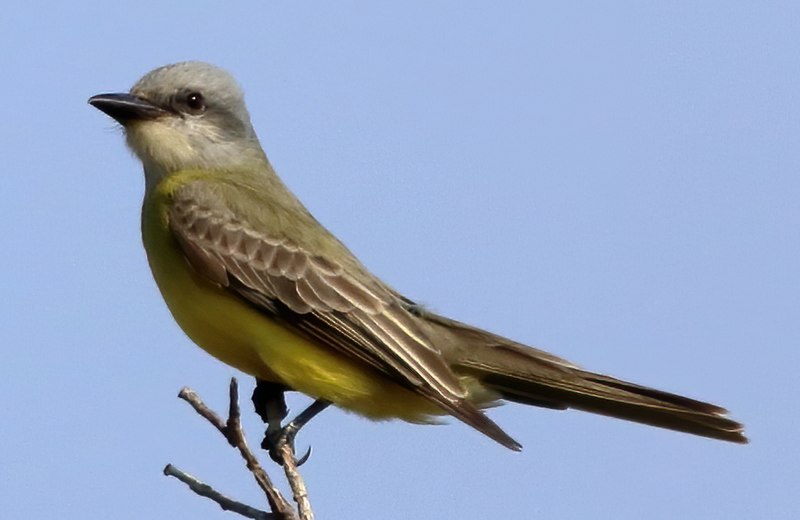
Couch’s kingbird is a passerine tyrant flycatcher found along the Gulf Coast, Yucatán Peninsula, Mexico and northern Guatemala. Named after soldier and naturalist Darius N.
Couch, this bird measures about 7 inches long with an olive green back and yellowish underside.
It has a white throat with dark streaks on its head while also having two bold white wing bars that are visible in flight.
The tail of this species is black tipped with whitish edges which helps it to be easily identified among other birds of similar size.
Its diet mainly consists of insects as well as berries during migration season when invertebrates become scarce in its habitat areas making it quite adaptive for survival purposes.Scientific classification:
| Kingdom | Animalia |
| Phylum | Chordata |
| Class | Aves |
| Order | Passeriformes |
| Family | Tyrannidae |
| Genus | Tyrannus |
| Species | T. couchii |
34. Greater Pewee
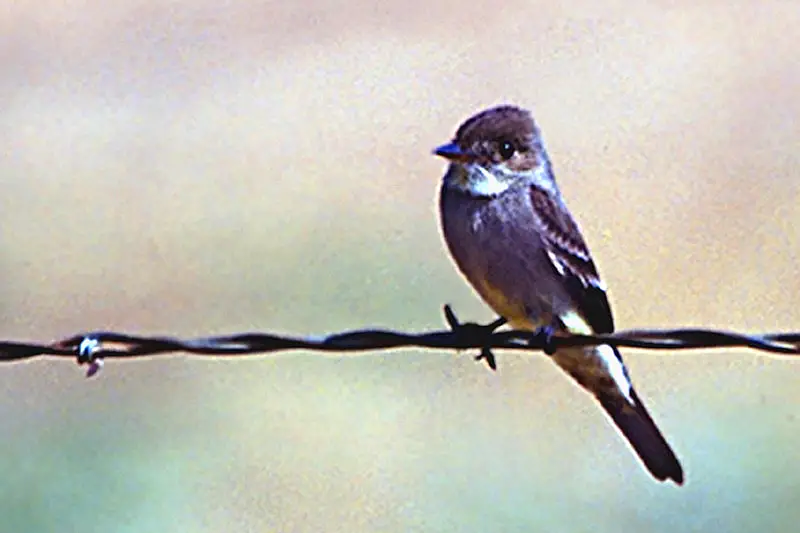
The Greater Pewee is a species of passerine bird that belongs to the tyrant flycatcher group. It has a larger range than other Mexican species and was formerly known as Coues’ Flycatcher.
This Grey-brown bird stands out due to its size, being slightly longer than an olive-sided flycatcher, making it the largest breeding Contopus flycatcher in the United States.
The male typically boasts a grayish crown with white stripes on either side along his forehead and cheeks, while their wings are mostly brownish with some lighter patches nears its body feathers.
In addition, they have two faint whitestrips running down each flank which helps them stand out from similarly colored birds during flight or when perched in trees or shrubs.Scientific classification:
| Kingdom | Animalia |
| Phylum | Chordata |
| Class | Aves |
| Order | Passeriformes |
| Family | Tyrannidae |
| Genus | Contopus |
| Species | C. pertinax |
35. Pine Flycatcher
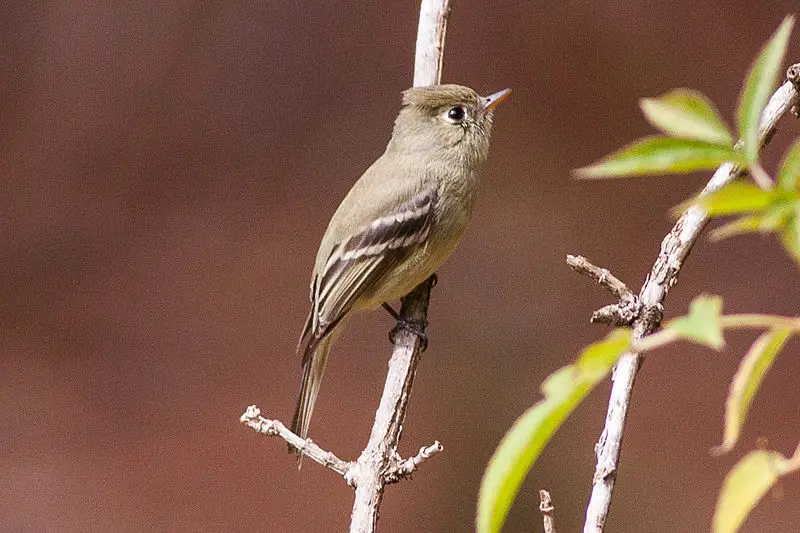
The Pine Flycatcher is a species of bird found in the montane tropical and subtropical coniferous forests of Mexico and southwestern Guatemala. It belongs to the family Tyrannidae, commonly known as tyrant flycatchers.
In May 2016, an extraordinary vagrant specimen was spotted in Arizona’s Santa Rita Mountains; this sighting marked its first record north of Mexico.
This small brownish-green bird has bright yellow underparts with gray or white wing bars on either side.
Its call consists of two distinct whistles that become louder when it is alarmed or excited. During mating season, males display their striking plumage by expanding their crest feathers while singing to attract potential mates – quite a sight.Scientific classification:
| Kingdom | Animalia |
| Phylum | Chordata |
| Class | Aves |
| Order | Passeriformes |
| Family | Tyrannidae |
| Genus | Empidonax |
| Species | E. affinis |
36. Sulphur-Bellied Flycatcher
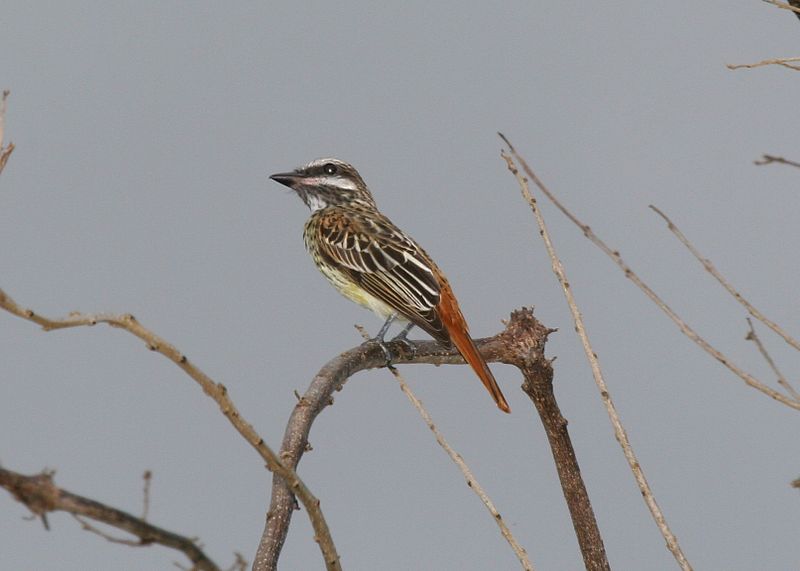
The Sulphur-bellied Flycatcher is a large tyrant flycatcher found in the southwestern United States and Mexico, down to Costa Rica.
These birds are short distance migrants, retreating from their breeding grounds during wintertime to spend it in the Andean foothills of Colombia, Ecuador, Peru, Bolivia and Brazil.
They have distinct yellow bellies with greyish upperparts and distinctive black wings that stand out against its white tail feathers.
Their calls consist of loud whistles followed by sharp rattling noises – used as communication between mates or when chasing away predators.
This species often feeds on flying insects such as beetles or wasps while hovering around trees close to water sources like ponds or rivers where they usually build nests made up of twigs lined up with grasses for their eggs and young chicks.Scientific classification:
| Kingdom | Animalia |
| Phylum | Chordata |
| Class | Aves |
| Order | Passeriformes |
| Family | Tyrannidae |
| Genus | Myiodynastes |
| Species | M. luteiventris |
37. Semicollared Flycatcher
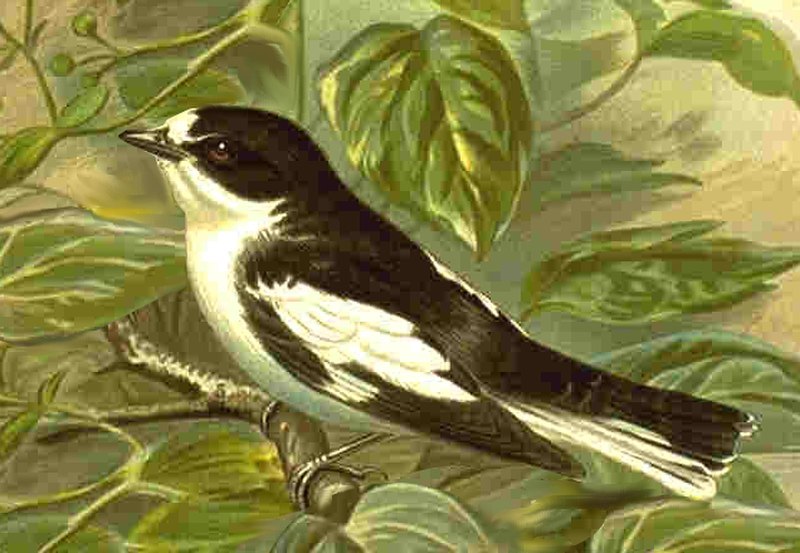
The Semicollared Flycatcher is a small passerine bird in the Old World flycatcher family, known for its unique black-and-white plumage.
It breeds primarily in montane forests of southeastern Europe and Northwest Iran, but migrates to Central and Eastern Africa during winter months.
This species has also been recorded as a rare vagrant in western Europe. Generally uncommon, it prefers open woodlands with plenty of shrubby vegetation to nest on or near the ground; they are rarely seen high up in trees unlike many other songbirds.
They feed their young mainly insects such as flies and beetles, which they catch while flying around low bushes searching for food sources.
The adults too consume these same items along with some fruits like cherries and berries when available seasonally. All considered this beautiful little bird adds character to any woodland setting.Scientific classification:
| Kingdom | Animalia |
| Phylum | Chordata |
| Class | Aves |
| Order | Passeriformes |
| Family | Muscicapidae |
| Genus | Ficedula |
| Species | F. semitorquata |
38. Social Flycatcher
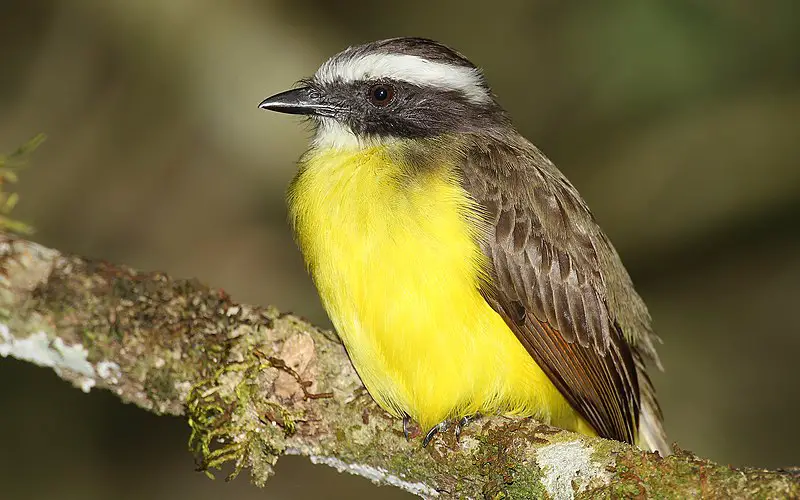
The Social Flycatcher is a medium-sized passerine bird from the Americas, belonging to the large tyrant flycatcher family.
It has often been split into two species – Myiozetetes texensis and Myiozetetes similis proper – due to its distinct range across Costa Rica northwards to Mexico and southward towards South America respectively.
This bird sports dark grey upperparts combined with white underparts, along with a vermilion crown on its head.
It also possesses an upright posture when perched which makes it easily recognizable in comparison with other birds of similar size within its habitat.
The social flycatcher feeds mainly on insects but can sometimes supplement these meals by eating fruits as well.Scientific classification:
| Kingdom | Animalia |
| Phylum | Chordata |
| Class | Aves |
| Order | Passeriformes |
| Family | Tyrannidae |
| Genus | Myiozetetes |
| Species | M. similis |
39. Blue-Throated Blue Flycatcher
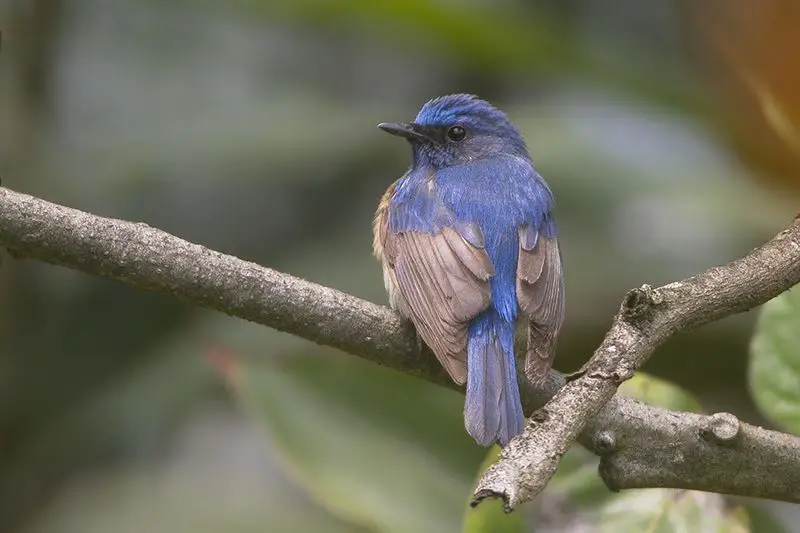
The Blue-throated blue flycatcher is a small passerine bird belonging to the Muscicapidae family. It has an unmistakable appearance, with its bright blue throat contrasting against its otherwise brown plumage.
This species can be found in much of the Indian Subcontinent, ranging from all through the Himalayas and plains to West Bengal.
Unlike other members of this genus, it prefers thicker forests as habitat rather than open areas or scrublands.
These birds mainly feed on insects which they catch by making short sallies into midair after taking off from perches at low levels among foliage and branches.
They are active during mornings and evenings when they become vocal while chirping away happily.Scientific classification:
| Kingdom | Animalia |
| Phylum | Chordata |
| Class | Aves |
| Order | Passeriformes |
| Family | Muscicapidae |
| Genus | Cyornis |
| Species | C. rubeculoides |
40. Variegated Flycatcher
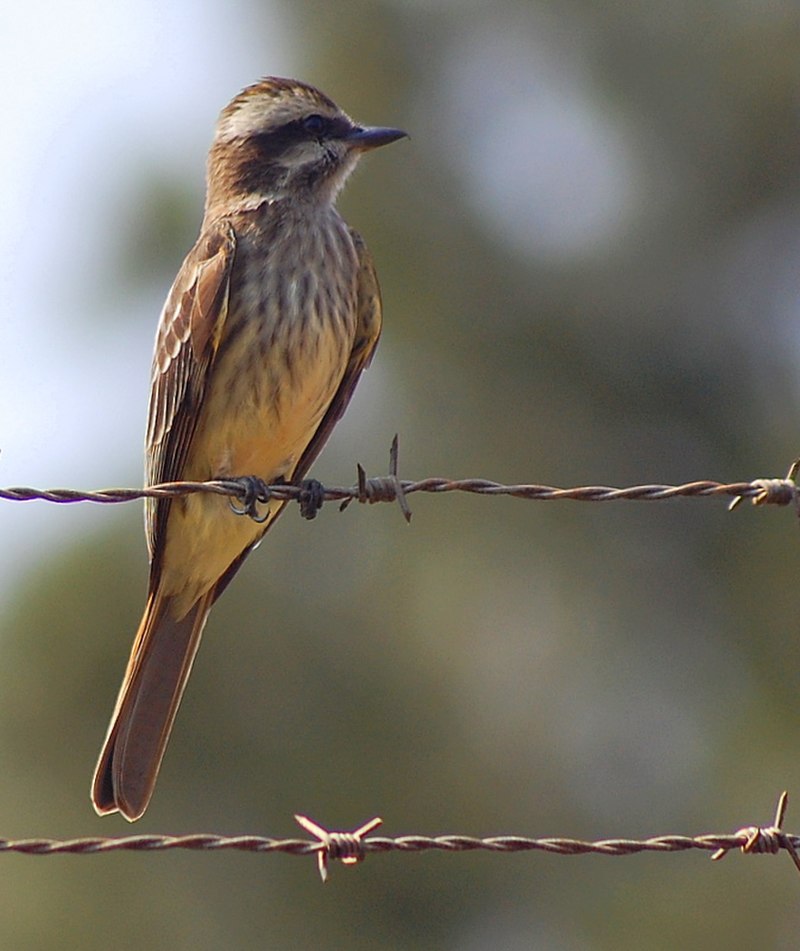
The Variegated Flycatcher is a species of bird found in South America, mostly in Argentina, Bolivia and Brazil. It belongs to the family Tyrannidae and it is now the only species left within its genus Empidonomus.
This small passerine has an olive-green upper body which gradually turns into yellow on its underparts with white patches near its wings.
Its tail feathers are tipped black giving them a distinctive look compared to other birds from the same family.
The Variegated Flycatcher feeds mainly on insects as well as some fruits such as berries making it omnivorous like many other flycatchers from similar regions across North America north of Mexico where they have been sighted accidentally by travelers and birdwatchers alike.Scientific classification:
| Kingdom | Animalia |
| Phylum | Chordata |
| Class | Aves |
| Order | Passeriformes |
| Family | Tyrannidae |
| Genus | Empidonomus Cabanis & Heine, 1859 |
| Species | E. varius |
41. Fork-Tailed Flycatcher
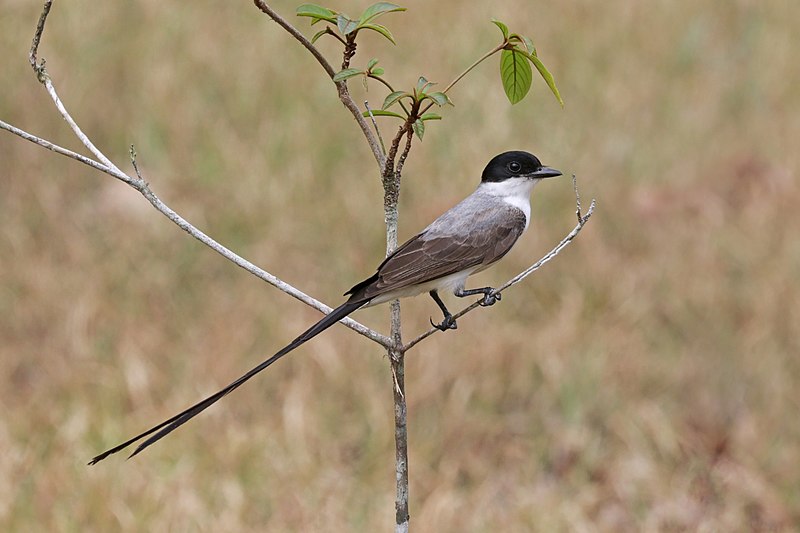
The Fork-tailed Flycatcher is a strikingly beautiful bird belonging to the tyrant flycatcher family. It has an unmistakable long and forked tail, which gives it its name.
This species can be found from southern Mexico all the way down to Argentina in lightly forested or grassland areas.
They are usually seen perched atop trees or other tall structures, surveying their surroundings with keen eyesight.
Though they may look intimidating due to their size, these birds feed on small insects like flies and beetles; making them beneficial predators that help keep insect populations under control.
Despite being widespread throughout much of South America, sadly this species is considered near threatened due to deforestation occurring in many of its habitats across range countries.Scientific classification:
| Kingdom | Animalia |
| Phylum | Chordata |
| Class | Aves |
| Order | Passeriformes |
| Family | Tyrannidae |
| Genus | Tyrannus |
| Species | T. savana |
42. Yellowish Flycatcher
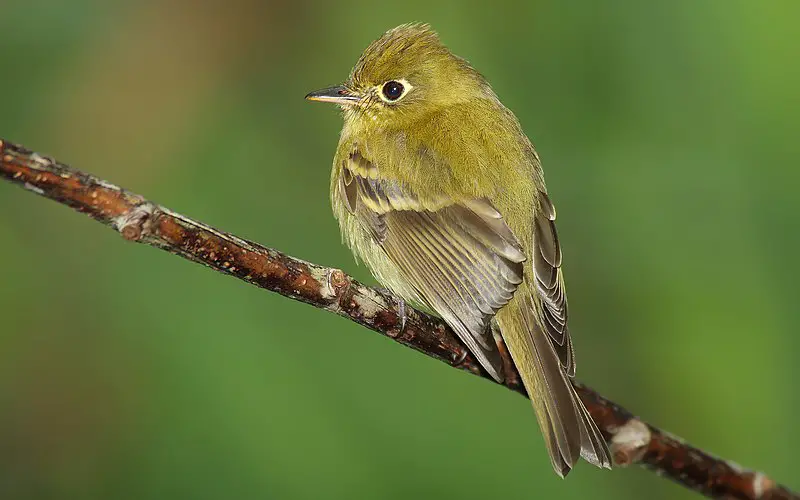
The Yellowish Flycatcher is a small passerine bird of the tyrant flycatcher family, found in highlands from southeastern Mexico to western Panama. It has olive-green upperparts and yellow underparts with an ochre tint on its breast.
Its wings are blackish with two buff wing bars which add to its distinctive appearance along with a grey head and white throat.
This species can be identified by its fast, fluttery flight style as it moves between perches while hunting for insects or other prey items.
In terms of habitat preferences, this species prefers open woodlands where they often nest in low shrubs or trees near water sources like streams or rivers.
Despite their wide range across Central America, populations have been declining due to deforestation and urbanization that reduce suitable habitats for them to thrive in.Scientific classification:
| Kingdom | Animalia |
| Phylum | Chordata |
| Class | Aves |
| Order | Passeriformes |
| Family | Tyrannidae |
| Genus | Empidonax |
| Species | E. flavescens |
43. Boat-Billed Flycatcher

The Boat-billed Flycatcher is a passerine bird, and the only member of its monotypic genus Megarynchus. It breeds in open woodland with tall trees from Mexico to Bolivia, Argentina and Trinidad.
The female builds an open saucer nest made of sticks for her two or three whitish eggs which are heavily blotched with brown spots.
This flycatcher has long legs, large eyes and a distinctive bill that resembles that of a boat due to its broad shape at the base near the nostrils.
Its upperparts are gray while it’s underparts have buffy wash on them; making this species quite unique compared to others in their family.
They feed mainly on insects by catching them midair but they can also be seen hunting low along branches like many other tyrant flycatchers do.
Although not considered endangered yet, deforestation may cause significant habitat loss for these birds as well as decreased insect populations which could lead to population declines if left unchecked.Scientific classification:
| Kingdom | Animalia |
| Phylum | Chordata |
| Class | Aves |
| Order | Passeriformes |
| Family | Tyrannidae |
| Genus | Megarynchus |
| Species | M. pitangua |
44. Chapada Flycatcher
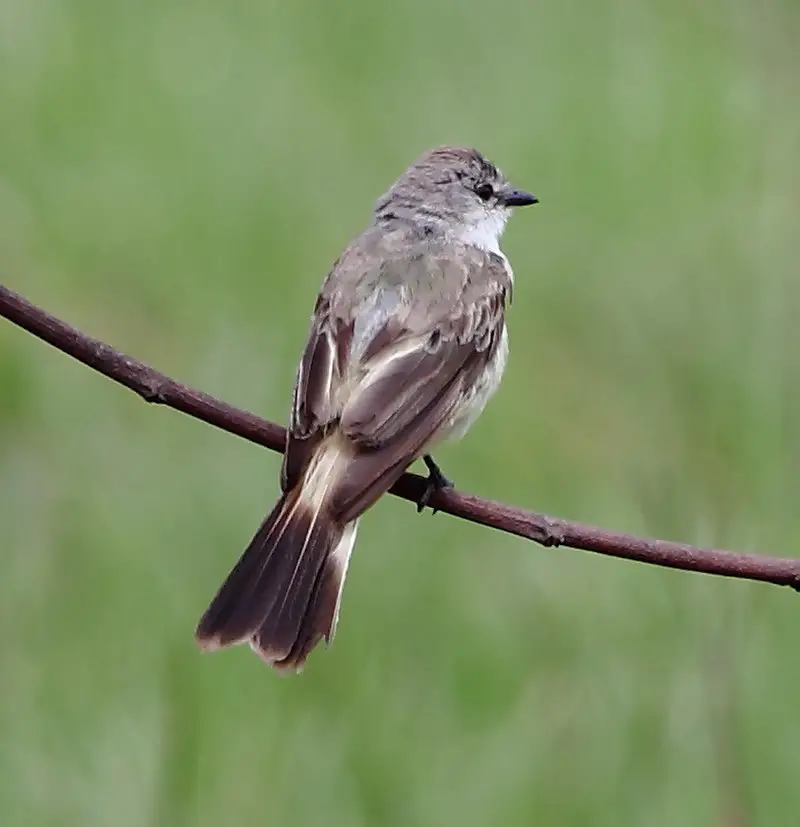
The Chapada Flycatcher is a species of bird belonging to the tyrannidae family, and it is placed in its own genus.
It belongs to the Animalia kingdom with Chordata as its phylum and Aves class – within which they are part of the Passeriformes order.
This small bird has grey-brownish plumage on their upperparts, white underparts and a black tail banded in yellow or white at times.
The chapada flycatcher also sports two large red eye spots that make them quite noticeable when perched upon branches or twigs.
They feed primarily upon insects such as beetles and caterpillars, utilizing perching techniques like most other tyrant flycatchers do during foraging sessions.
These birds can be found mainly in tropical rainforests from Mexico, Guatemala all the way down south into Panama where they inhabit dense tree canopies along streams near waterfalls; making loud calls while doing so.Scientific classification:
| Kingdom | Animalia |
| Phylum | Chordata |
| Class | Aves |
| Order | Passeriformes |
| Family | Tyrannidae |
| Genus | Guyramemua Lopes, Chaves, Mendes de Aquino, Silveira & Santos, FR, 2017 |
| Species | G. affine |
45. Nutting’s Flycatcher
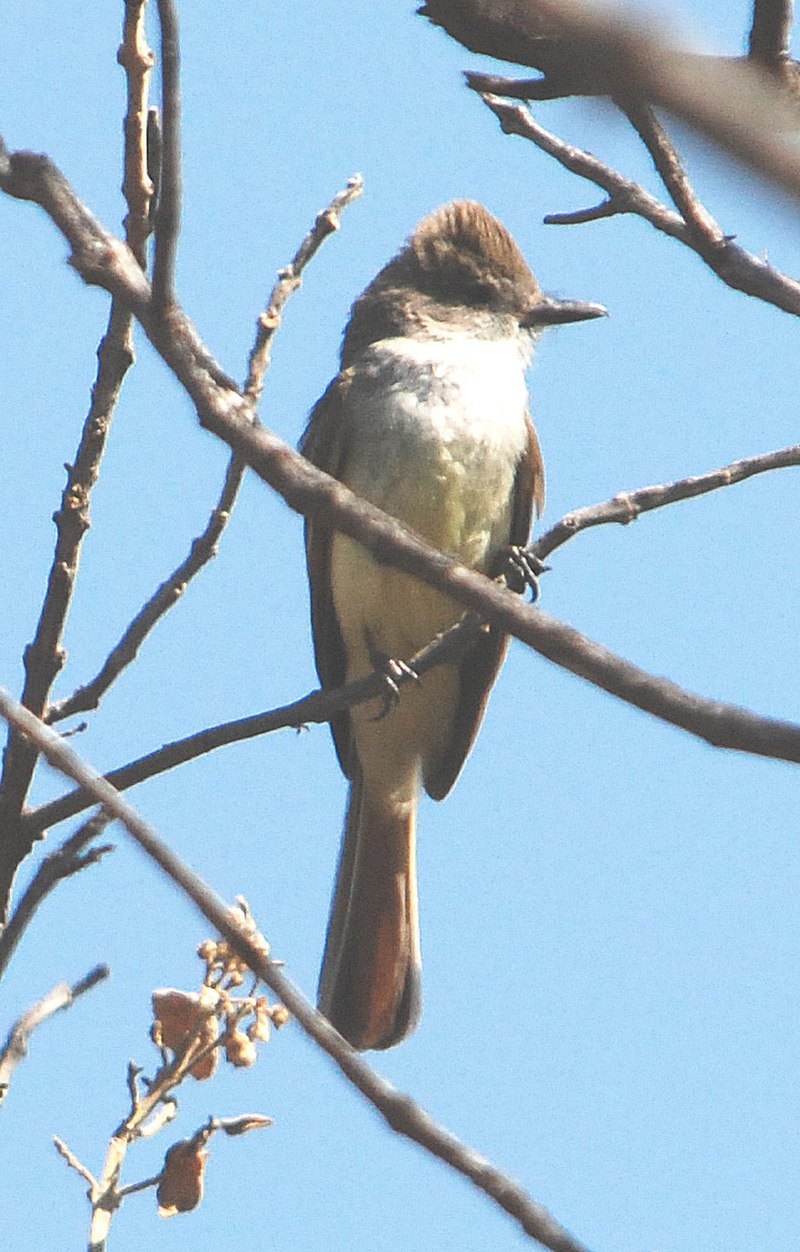
Nutting’s flycatcher is a small passerine bird of the tyrant flycatcher family. It breeds in semi-arid desert scrub and tropical deciduous forest from western Mexico to northwest Costa Rica, where it usually resides year-round.
However, they are also known to be occasional vagrants in Arizona and California (southeastern, central and western).
The species was named after American naturalist Charles E. Nutting who first described them in 1912.
They have dark olive upperparts with yellowish on their lower breast area as well as bright eyes paired with grey legs; males tend to have more vibrant colors than females do.
These birds feed mainly on insects which they catch midair or from foliage but will take some berries too if available during winter months when other food sources become scarce.Scientific classification:
| Kingdom | Animalia |
| Phylum | Chordata |
| Class | Aves |
| Order | Passeriformes |
| Family | Tyrannidae |
| Genus | Myiarchus |
| Species | M. nuttingi |
46. Green-Backed Flycatcher
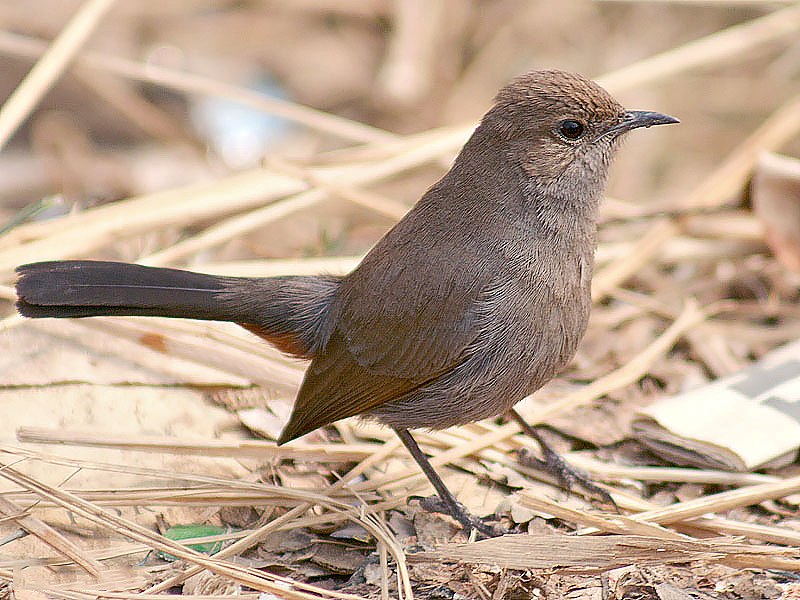
The Green-backed Flycatcher is a species of bird found in northeast China and parts of southeast Asia. They belong to the family Muscicapidae, which includes Old World flycatchers.
These birds have been known to be distinct from their closely related cousin – the Narcissus Flycatcher – due to differences in morphology and sound patterns.
During breeding season these small birds settle in northeastern China before heading south for wintering grounds during colder months.
Interestingly enough, there has also been a proposed subspecies called “F Beijingnica” that may or may not be separate from this species although more research is needed on it’s taxonomic status at present time.Scientific classification:
| Kingdom | Animalia |
| Phylum | Chordata |
| Class | Aves |
| Order | Passeriformes |
| Family | Muscicapidae |
| Genus | Ficedula |
| Species | F. elisae |
47. Pale-Eyed Pygmy Tyrant
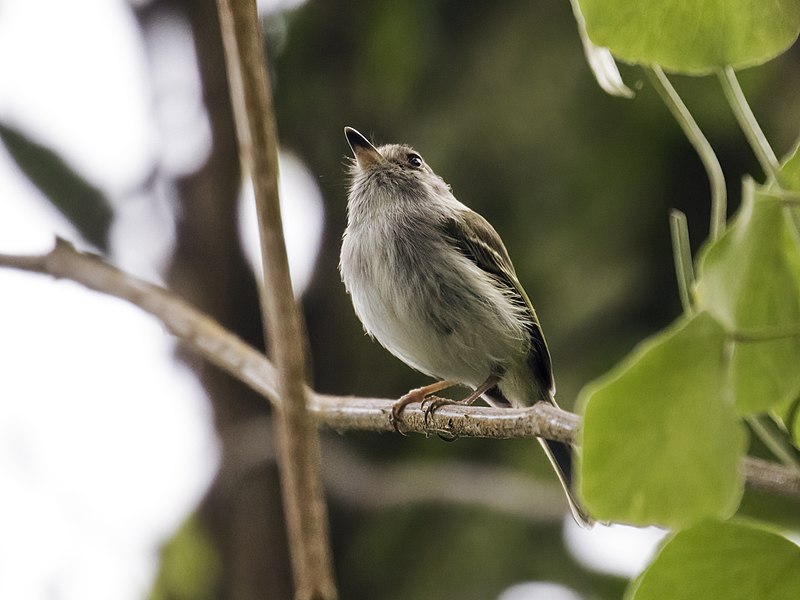
The Pale-eyed pygmy tyrant is a species of bird in the Tyrannidae family, making it unique to its own genus Atalotriccus.
It inhabits subtropical and tropical dry forests as well as moist lowland forests from Brazil, Colombia, Guyana, Panama and Venezuela.
They are distinguished by their pale eyes with greyish underparts that have an olive wash on them.
This small flycatcher has short wings which makes them agile hunters while they search for food like insects or other invertebrates in the canopy of trees where they make nests out of soft materials such as mosses or lichens.
The male Pale-eyed Pygmy Tyrant takes part in courtship displays during breeding season where he vigorously flaps his wings up and down while singing a variety of songs to attract females.Scientific classification:
| Kingdom | Animalia |
| Phylum | Chordata |
| Class | Aves |
| Order | Passeriformes |
| Family | Tyrannidae |
| Genus | Atalotriccus Ridgway, 1905 |
| Species | A. pilaris |
48. Cinnamon Attila

The Cinnamon Attila is a species of bird in the Tyrannidae family, commonly found in northern South America.
It inhabits subtropical and tropical swamps, specifically within the Amazon Basin across Brazil, Colombia, Venezuela, Guyana, Suriname and French Guiana as well as parts of Ecuador Peru and Bolivia.
These birds are small to medium-sized with grayish-brown upperparts which give way to pale yellow underparts that have faint streaking on their chest.
They also feature distinctive orange or rust colored eyespots over each eye – this may be used for communication between members of its own species or scare away predators.
The Cinnamon Atilla feeds mainly on insects such as grasshoppers but will occasionally take fruits from nearby trees when available.Scientific classification:
| Kingdom | Animalia |
| Phylum | Chordata |
| Class | Aves |
| Order | Passeriformes |
| Family | Tyrannidae |
| Genus | Attila |
| Species | A. cinnamomeus |
49. Citron-Bellied Attila

The Citron-bellied Attila is a species of bird belonging to the family Tyrannidae. It is found in Brazil, Colombia, Ecuador, Peru and Venezuela living in subtropical or tropical lowland forests.
This attractive bird has bright yellow underparts contrasting with its dark upper parts making it easily identifiable amongst other birds.
A rare sight within these countries due to their declining population size caused by deforestation and human settlements which have disrupted their natural environment.
Despite being listed as near threatened on The International Union for Conservation of Nature’s Red List of Threatened Species there are conservation efforts underway that aim at preserving this little known creature before it becomes endangered forever.Scientific classification:
| Kingdom | Animalia |
| Phylum | Chordata |
| Class | Aves |
| Order | Passeriformes |
| Family | Tyrannidae |
| Genus | Attila |
| Species | A. citriniventris |
50. Ochraceous Attila
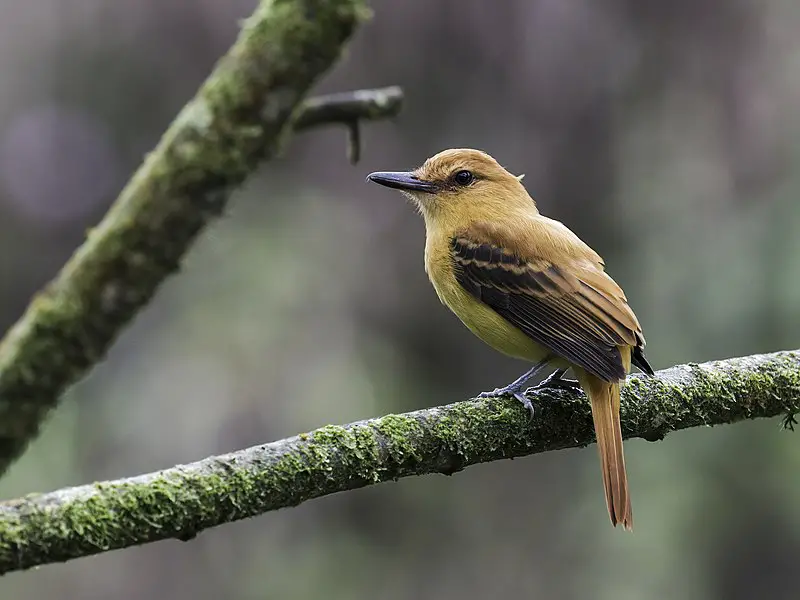
The ochraceous attila is a unique species of bird found in the tropical lowland regions of Colombia, Ecuador and Peru. This small bird has an olive-brown back and wings with an orange or light yellow belly.
It lives mainly in moist forests as well as plantations, but its habitat is under threat due to deforestation which puts it at risk for extinction.
The diet consists mostly of insects that they catch while flying around trees and other vegetation.
They breed during the dryer months when more food sources are available, laying their eggs on branches or vines near water sources such as rivers or streams.
To help protect this species from further decline we must take measures to preserve its natural habitats by encouraging conservation efforts throughout South America where these birds reside.Scientific classification:
| Kingdom | Animalia |
| Phylum | Chordata |
| Class | Aves |
| Order | Passeriformes |
| Family | Tyrannidae |
| Genus | Attila |
| Species | A. torridus |